LINKSYS WTR54GSV21 Wireless-G Travel Router with SpeedBooster User Manual Book
LINKSYS LLC Wireless-G Travel Router with SpeedBooster Book
LINKSYS >
Manual
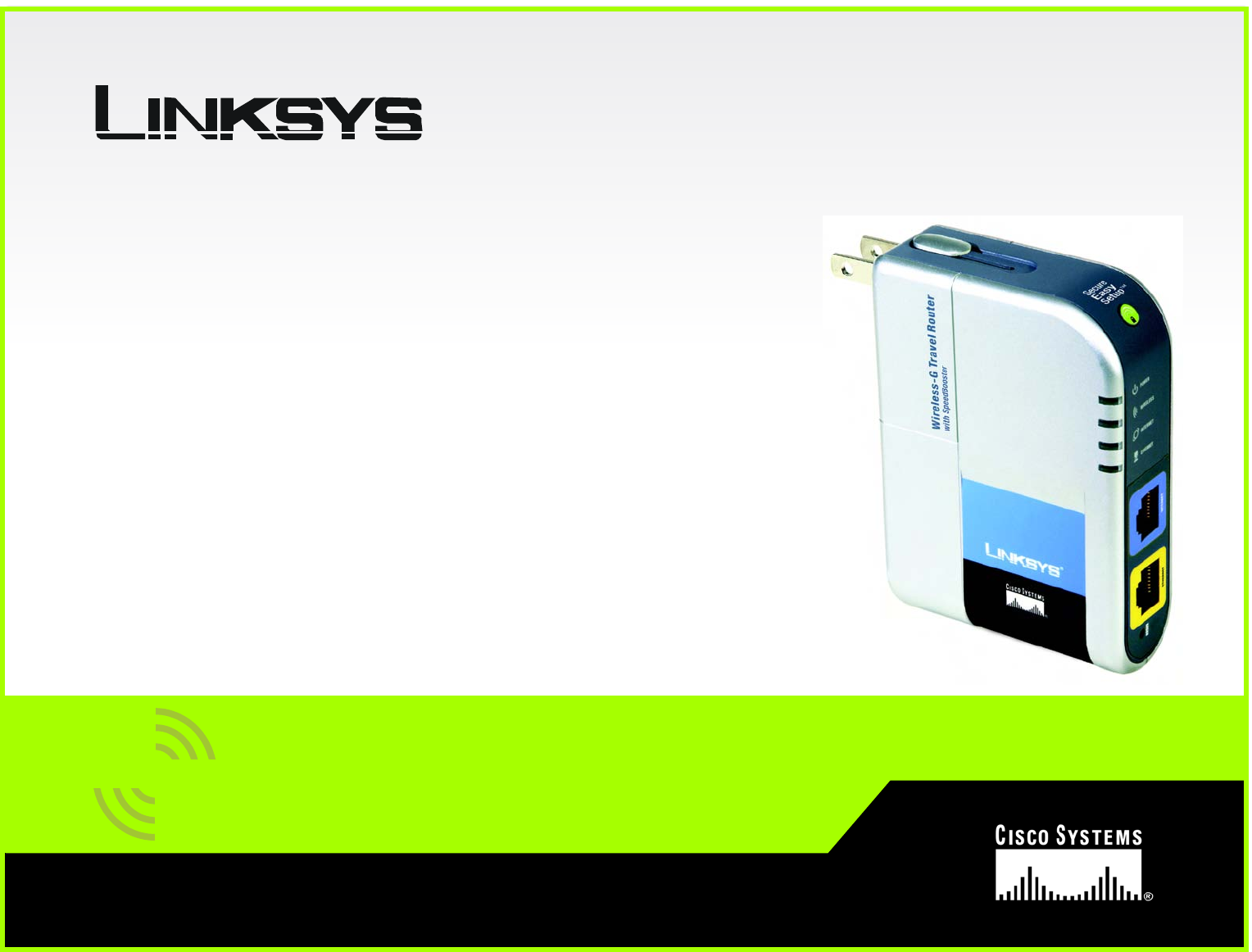
A Division of Cisco Systems, Inc.
®
Model No.
Travel Router
Wireless-G
WTR54GS ver2.1
User Guide
WIRELESS with SpeedBooster
FCC and IC Statement
Federal Communication Commission Interference Statement
This equipment has been tested and found to comply with the limits for
a Class B digital device, pursuant to Part 15 of the FCC Rules. These limits
are designed to provide reasonable protection against harmful interference in
a residential installation. This equipment generates, uses and can radiate
radio frequency energy and, if not installed and used in accordance with the
instructions, may cause harmful interference to radio communications.
However, there is no guarantee that interference will not occur in a particular
installation. If this equipment does cause harmful interference to radio or
television reception, which can be determined by turning the equipment off
and on, the user is encouraged to try to correct the interference by one of the
following measures:
- Reorient or relocate the receiving antenna.
- Increase the separation between the equipment and receiver.
- Connect the equipment into an outlet on a circuit different from that
to which the receiver is connected.
- Consult the dealer or an experienced radio/TV technician for help.
This device complies with Part 15 of the FCC Rules. Operation is
subject to the following two conditions: (1) This device may not cause harmful
interference, and (2) this device must accept any interference received,
including interference that may cause undesired operation.
FCC Caution: Any changes or modifications not expressly approved by
the party responsible for compliance could void the user's authority to operate
this equipment.
IMPORTANT NOTE: FCC Radiation Exposure Statement:
This equipment complies with FCC radiation exposure limits set forth
for an uncontrolled environment. This equipment should be installed and
operated with minimum distance 20cm between the radiator & your body.
This transmitter must not be co-located or operating in conjunction with
any other antenna or transmitter.
We declare that the product is limited in CH1~CH11 by specified
firmware controlled in the USA.
IC statement
Operation is subject to the following two conditions:
1) This device may not cause interference and
2) This device must accept any interference, including interference that may
cause undesired operation of the device.
IMPORTANT NOTE:
IC Radiation Exposure Statement:
This equipment complies with IC radiation exposure limits set forth for an
uncontrolled environment. End users must follow the specific operating
instructions for satisfying RF exposure compliance. This equipment should be
installed and operated with minimum distance 20cm between the radiator &
your body.
This transmitter must not be co-located or operating in conjunction with any
other antenna or transmitter.
Règlement d’Industry Canada
Les conditions de fonctionnement sont sujettes à deux conditions:
1) Ce périphérique ne doit pas causer d’interférence et.
2) Ce périphérique doit accepter toute interférence, y compris les interférences
pouvant perturber le bon fonctionnement de ce périphérique.
用 FinePrint 列印 -可在 www.fineprint.com 訂購

Wireless-G Travel Router with SpeedBooster
Copyright and Trademarks
Specifications are subject to change without notice. Linksys is a registered trademark or trademark of Cisco
Systems, Inc. and/or its affiliates in the U.S. and certain other countries. Copyright © 2005 Cisco Systems, Inc. All
rights reserved. Other brands and product names are trademarks or registered trademarks of their respective
holders.
How to Use This User Guide
This User Guide has been designed to make understanding networking with the Wireless-G Travel Router with
SpeedBooster easier than ever. Look for the following items when reading this User Guide:
In addition to these symbols, there are definitions for technical terms that are presented like this:
Also, each figure (diagram, screenshot, or other image) is provided with a figure number and description, like
this:
Figure numbers and descriptions can also be found in the “List of Figures” section in the “Table of Contents”.
This exclamation point means there is a caution or warning
and is something that could damage your property or the
Wireless-G Travel Router with SpeedBooster
This checkmark means there is a note of interest and is
something you should pay special attention to while using
the Wireless-G Travel Router with SpeedBooster .
This question mark provides you with a reminder about
something you might need to do while using the
Wireless-G Travel Router with SpeedBooster .
word: definition.
Figure 0-1: Sample Figure Description
WTR54GS-UG-50520NC BW
WARNING: This product contains chemicals, including lead, known
to the State of California to cause cancer, and birth defects or other
reproductive harm. Wash hands after handling.

Wireless-G Travel Router with SpeedBooster
Table of Contents
Chapter 1: Introduction 1
Welcome 1
What’s in this Guide? 2
Chapter 2: Planning Your Wireless Network 4
Network Topology 4
Ad-Hoc versus Infrastructure Mode 4
Network Layout 4
Chapter 3: Getting to Know the Wireless-G Travel Router with SpeedBooster 6
The Front Panel 6
The Power Plug and Slide 7
Chapter 4: Connecting the Wireless-G Travel Router with SpeedBooster 8
Overview 8
Hardware Installation 8
Chapter 5: Configuring the Wireless-G Travel Router with SpeedBooster 10
Overview 10
How to Access the Web-based Utility 11
The Setup Tab - Basic Setup 11
The Setup Tab - DDNS 16
The Setup Tab - MAC Address Clone 17
The Setup Tab - Advanced Routing 18
The Wireless Tab - Basic Wireless Settings 19
The Wireless Tab - Wireless Security 21
The Wireless Tab - Wireless MAC Filter 23
The Wireless Tab - Advanced Wireless Settings 24
The Security Tab - Firewall 26
The Security Tab - VPN Passthrough 27
The Security Tab - VPN 27
The Access Restrictions Tab - Internet Access Policy 31
The Applications and Gaming Tab - Port Range Forwarding 33
The Applications & Gaming Tab - Port Range Triggering 35
The Applications and Gaming Tab - DMZ 36
The Administration Tab - Management 37

Wireless-G Travel Router with SpeedBooster
The Administration Tab - Log 39
The Administration Tab - Diagnostics 40
The Administration Tab - Factory Defaults 41
The Administration Tab - Firmware Upgrade 41
The Status Tab - Router 42
The Status Tab - Local Network 43
The Status Tab - Wireless 44
Appendix A: Troubleshooting 45
Common Problems and Solutions 45
Frequently Asked Questions 53
Appendix B: Wireless Security 60
Security Precautions 60
Security Threats Facing Wireless Networks 60
Appendix C: Upgrading Firmware 63
Appendix D: Windows Help 64
Appendix E: Finding the MAC Address and IP Address for Your Ethernet Adapter 65
Windows 98SE or Me Instructions 65
Windows 2000 or XP Instructions 65
For the Router’s Web-based Utility 66
Appendix F: Glossary 67
Appendix G: Specifications 74
Appendix H: Warranty Information 76
Appendix I: Regulatory Information 77
Appendix J: Contact Information 79

Wireless-G Travel Router with SpeedBooster
List of Figures
Figure 3-1: The Router’s Front Panel 6
Figure 3-2: The Router’s Power Plug and Slide 7
Figure 4-1: Connecting to the Internet 8
Figure 4-2: Connecting to the PC 9
Figure 4-3: Connecting the Power 9
Figure 5-1: Router’s IP Address 11
Figure 5-2: Router Login Screen 11
Figure 5-3: Basic Setup 11
Figure 5-4: Wireless Internet Type 12
Figure 5-5: Setup Tab - Basic Setup - DHCP Internet Connection Type 12
Figure 5-6: Static IP Connection Type 13
Figure 5-7: PPPoE Connection Type 13
Figure 5-8: PPTP Connection Type 14
Figure 5-9: Static DHCP Client List 15
Figure 5-10: DHCP Client Table 15
Figure 5-11: DynDNS.org 16
Figure 5-12: TZO.com 17
Figure 5-13: Setup Tab - MAC Address Clone 17
Figure 5-14: Setup Tab - Advanced Routing 18
Figure 5-15: Setup Tab - Advanced Routing - Routing Table 18
Figure 5-16: Wireless Tab - Basic Wireless Settings 19
Figure 5-17: Wireless Tab - Wireless Security (WEP) 21
Figure 5-18: Wireless Tab - Wireless Security (WPA Personal) 21
Figure 5-19: Wireless Tab - Wireless Security (WPA2-Personal) 22
Figure 5-20: Wireless Tab - Wireless Security (WPA2-Mixed) 22
Figure 5-21: Wireless Tab - Wireless MAC Filter 23
Figure 5-22: Wireless Tab - Wireless Client List 23
Figure 5-23: Wireless Tab - Advanced Wireless Settings 24
Figure 5-24: Security Tab - Firewall 26
Figure 5-25: Security Tab - VPN Passthrough 27

Wireless-G Travel Router with SpeedBooster
Figure 5-26: Security Tab - VPN 27
Figure 5-27: Security Tab - VPN - Summary 28
Figure 5-28: Security Tab - VPN - Advanced VPN Tunnel Setup 30
Figure 5-29: Access Restrictions Tab - Internet Access Policy 31
Figure 5-30: Access Restrictions Tab - Summary 32
Figure 5-31: Access Restrictions Tab - Internet Access PCs List 32
Figure 5-32: Applications and Gaming Tab - Port Range Forwarding 33
Figure 5-33: Applications and Gaming Tab - Port Range Triggering 35
Figure 5-34: Applications and Gaming Tab - DMZ 36
Figure 5-35: Administration Tab - Management 37
Figure 5-36: Administration Tab - Log 39
Figure 5-37: Incoming Log 39
Figure 5-38: Administration Tab - Diagnostics 40
Figure 5-39: Ping Test 40
Figure 5-40: Traceroute Test 40
Figure 5-41: Administration Tab - Factory Defaults 41
Figure 5-42: Administration Tab - Firmware Upgrade 41
Figure 5-43: Status Tab - Router 42
Figure 5-44: Status Tab - Local Network 43
Figure 5-45: DHCP Client Table 43
Figure 5-46: Status Tab - Wireless 44
Figure C-1: Administration Tab - Firmware Upgrade 63
Figure E-1: IP Configuration Screen 65
Figure E-2: MAC Address/Adapter Address 65
Figure E-3: MAC Address/Physical Address 65
Figure E-4: Wireless MAC Filter List 66
Figure E-5: MAC Address Clone 66

1
Chapter 1: Introduction
Welcome
Wireless-G Travel Router with SpeedBooster
Chapter 1: Introduction
Welcome
Thank you for choosing the Linksys Wireless-G Travel Router with SpeedBooster. The Wireless-G Travel Router
with SpeedBooster will allow you to network wirelessly better than ever, sharing Internet access, files and fun,
easily and securely while away from home.
How does the Wireless-G Travel Router with SpeedBooster do all of this? The Router has a built-in access point,
which lets you connect SpeedBooster-enhanced and regular Wireless-G and Wireless-B devices to the network.
There's also an Ethernet port to connect your wired PC. The Router function ties it together and lets your PCs
share a wired or wireless Internet connection. The travel-friendly form factor includes a built-in power supply and
antenna, and it comes with a travel case. Just plug the Router directly into the wall, and connect the hotel's fast
Internet service cable. Then use the Router's push button setup feature to easily connect and configure your
wireless devices. You just push the button on the Router and on your other SecureEasySetup-enabled wireless
device to automatically create a WPA or WEP encryption-secured wireless connection. You can also use multiple
devices on a single hotspot account in a coffee shop or airport lounge and be protected with WPA Personal
encryption or a powerful SPI firewall. The Router also supports VPN pass-through and it can serve as a DHCP
Server.
But what does all of this mean?
Networks are useful tools for sharing computer resources. You can access one printer from different computers
and access data located on another computer's hard drive. Networks are even used for playing multiplayer video
games. So, networks are not only useful in homes and offices, they can also be fun.
PCs on a wired network create a LAN, or Local Area Network. They are connected with Ethernet cables, which is
why the network is called “wired”.
PCs equipped with wireless cards or adapters can communicate without cumbersome cables. By sharing the
same wireless settings, within their transmission radius, they form a wireless network. This is sometimes called
a WLAN, or Wireless Local Area Network. The Wireless-G Travel Router with SpeedBooster bridges wireless
networks of 802.11a, 802.11b, and 802.11g standards and wired networks, allowing them to communicate with
each other.
Linksys recommends using the Setup CD-ROM for first-time installation of the Router. If you do not wish to run
the Setup Wizard on the Setup CD-ROM, then use the instructions in this Guide to help you connect the
Wireless-G Travel Router with SpeedBooster, set it up, and configure it to bridge your network. These instructions
should be all you need to get the most out of the Wireless-G Travel Router with SpeedBooster.
ethernet: an IEEE standard network protocol that
specifies how data is placed on and retrieved from
a common transmission medium.
lan (local area network): the computers and
networking products that make up the network
in your home or office.
802.11b: an IEEE wireless networking standard
that specifies a maximum data transfer rate of
11Mbps and an operating frequency of 2.4GHz.
802.11g: an IEEE wireless networking standard
that specifies a maximum data transfer rate of
54Mbps, an operating frequency of 2.4GHz, and
backward compatibility with 802.11b devices.
browser: an application program that
provides a way to look at and interact with all
the information on the World Wide Web.
mbps: one million bits per second; a unit of
measurement for data transmission.
nat (network address translation): NAT
technology translated IP addresses of a
local area network to a different IP address
for the Internet.

2
Chapter 1: Introduction
What’s in this Guide?
Wireless-G Travel Router with SpeedBooster
What’s in this Guide?
This user guide covers the steps for setting up and using the Wireless-G Travel Router with SpeedBooster.
• Chapter 1: Introduction
This chapter describes the Router’s applications and this User Guide.
• Chapter 2: Planning Your Wireless Network
This chapter describes the basics of wireless networking.
• Chapter 3: Getting to Know the Wireless-G Travel Router with SpeedBooster
This chapter describes the physical features of the Router.
• Chapter 4: Connecting the Wireless-G Travel Router with SpeedBooster
This chapter instructs you on how to connect the Router to your network.
• Chapter 5: Configuring the Wireless-G Travel Router with SpeedBooster
This chapter explains how to use the Web-Based Utility to configure the settings on the Wireless-G Travel
Router with SpeedBooster.
• Appendix A: Troubleshooting
This appendix describes some problems and solutions, as well as frequently asked questions, regarding
installation and use of the Wireless-G Travel Router with SpeedBooster.
• Appendix B: Wireless Security
This appendix explains the risks of wireless networking and some solutions to reduce the risks.
• Appendix C: Upgrading Firmware
This appendix instructs you on how to upgrade the firmware on the Router should you need to do so.
• Appendix D: Windows Help
This appendix describes how you can use Windows Help for instructions about networking, such as installing
the TCP/IP protocol.
• Appendix E: Finding the MAC Address and IP Address for your Ethernet Adapter.
This appendix describes how to find the MAC address for your computer’s Ethernet adapter so you can use
the MAC filtering and/or MAC address cloning feature of the Router.
• Appendix F: Glossary
This appendix gives a brief glossary of terms frequently used in networking.

3
Chapter 1: Introduction
What’s in this Guide?
Wireless-G Travel Router with SpeedBooster
• Appendix G: Specifications
This appendix provides the technical specifications for the Router.
• Appendix H: Warranty Information
This appendix supplies the warranty information for the Router.
• Appendix I: Regulatory Information
This appendix supplies the regulatory information regarding the Router.
• Appendix J: Contact Information
This appendix provides contact information for a variety of Linksys resources, including Technical Support.

4
Chapter 2: Planning Your Wireless Network
Network Topology
Wireless-G Travel Router with SpeedBooster
Chapter 2: Planning Your Wireless Network
Network Topology
A wireless local area network (WLAN) is exactly like a regular local area network (LAN), except that each
computer in the WLAN uses a wireless device to connect to the network. Computers in a WLAN share the same
frequency channel and SSID, which is an identification name shared by the wireless devices belonging to the
same wireless network.
Ad-Hoc versus Infrastructure Mode
Unlike wired networks, wireless networks have two different modes in which they may be set up: infrastructure
and ad-hoc. An infrastructure configuration is a WLAN and wired LAN communicating to each other through an
access point. An ad-hoc configuration is wireless-equipped computers communicating directly with each other.
Choosing between these two modes depends on whether or not the wireless network needs to share data or
peripherals with a wired network or not.
If the computers on the wireless network need to be accessible by a wired network or need to share a peripheral,
such as a printer, with the wired network computers, the wireless network should be set up in Infrastructure
mode. The basis of Infrastructure mode centers around a wireless router or an access point, such as the
Wireless-G Travel Router with SpeedBooster, which serves as the main point of communications in a wireless
network. The Router transmits data to PCs equipped with wireless network adapters, which can roam within a
certain radial range of the Router. You can arrange the Router and multiple access points to work in succession
to extend the roaming range, and you can set up your wireless network to communicate with your Ethernet
hardware as well.
If the wireless network is relatively small and needs to share resources only with the other computers on the
wireless network, then the Ad-Hoc mode can be used. Ad-Hoc mode allows computers equipped with wireless
transmitters and receivers to communicate directly with each other, eliminating the need for a wireless router or
access point. The drawback of this mode is that in Ad-Hoc mode, wireless-equipped computers are not able to
communicate with computers on a wired network. And, of course, communication between the wireless-
equipped computers is limited by the distance and interference directly between them.
Network Layout
The Wireless-G Travel Router with SpeedBooster has been specifically designed for use with your 802.11b and
802.11g products. Now, products using these standards can communicate with each other.
infrastructure: a wireless network
that is bridged to a wired network via
an access point.
ssid: your wireless network’s name.
ad-hoc: a group of wireless devices
communicating directly to each other
(peer-to-peer) without the use of an
access point.
access point: a device that allows wireless-
equipped computers and other devices to
communicate with a wired network. Also used
to expand the range of a wireless network.
adapter: a device that adds
network functionality to your PC.
ethernet: IEEE standard network protocol that
specifies how data is placed on and retrieved
from a common transmission medium.
network: a series of computers or devices
connected for the purpose of data sharing,
storage, and/or transmission between users.

5
Chapter 2: Planning Your Wireless Network
Network Layout
Wireless-G Travel Router with SpeedBooster
The Wireless-G Travel Router with SpeedBooster is compatible with 802.11b and 802.11g adapters, such as the
Notebook Adapter (WPC54GS) for your laptop computers, PCI Adapter (WMP54GS) for your desktop PC, and USB
Adapter (WUSB54GS) when you want to enjoy USB connectivity.
With these, and many other, Linksys products, your networking options are limitless. Go to the Linksys website at
www.linksys.com for more information about products that work with the Wireless-G Travel Router with
SpeedBooster.
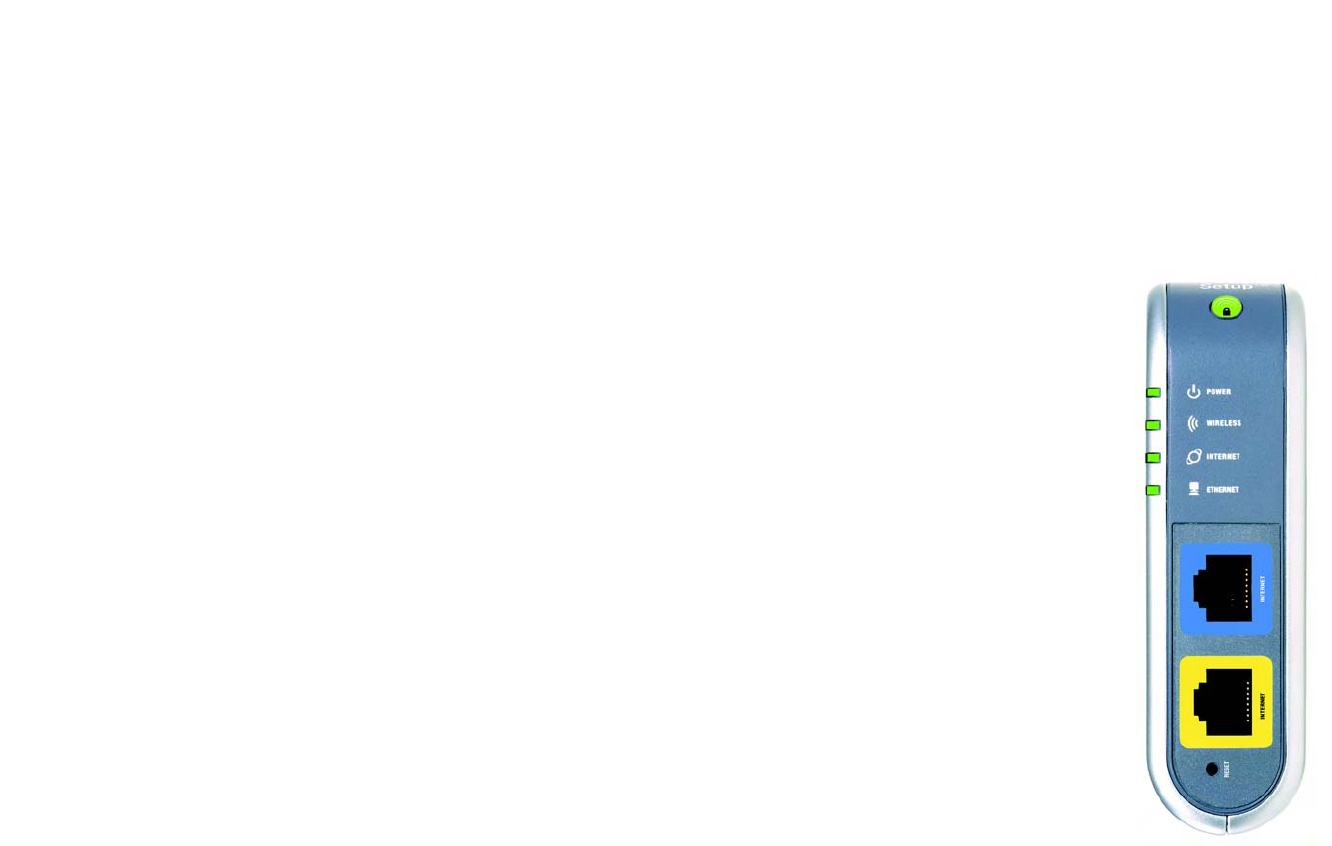
6
Chapter 3: Getting to Know the Wireless-G Travel Router with SpeedBooster
The Front Panel
Wireless-G Travel Router with SpeedBooster
Chapter 3: Getting to Know the Wireless-G Travel Router
with SpeedBooster
The Front Panel
The Router’s ports, LEDs, and buttons are located here.
LEDs
Power Green. The Power LED lights up and will stay on while the Router is powered on. When the
Router goes through its self-diagnostic mode during every boot-up, this LED will be orange.
When the diagnostic is complete, the LED will be solidly lit.
Wireless Green. The WLAN LED flashes when there is a successful wireless connection.
Internet Green. The Internet LED lights up when there is a connection made through the Internet
port.
Ethernet Green. If the LED is continuously lit, the Router is successfully connected to a device through
that port. A flashing LED indicates network activity over that port.
Ports
Ethernet This port connects the Router to your networked PC and other Ethernet network devices.
Internet The Internet port is where you will connect your broadband Internet connection.
Figure 3-1: The Router’s Front Panel
broadband: an always-on, fast Internet
connection.

7
Chapter 3: Getting to Know the Wireless-G Travel Router with SpeedBooster
The Power Plug and Slide
Wireless-G Travel Router with SpeedBooster
Buttons
Reset There are two ways to reset the Router's factory defaults. Either press the Reset button,
for approximately eight seconds, or restore the defaults from the Administration tab -
Factory Defaults in the Router's Web-based Utility.
Secure Easy Setup The Secure Easy Setup sets up and configures your wireless devices. Push the Secure Easy
Setup button on the Router and on your other SecureEasySetup-enabled wireless devices
to automatically create a wireless connection.
The Power Plug and Slide
The Router’s Power Plug is located on the back panel and the Power Slide is located on the top panel.
Power Plug The Power plug is where you will connect the Router to the electrical outlet.
Power Slide Slide the Power Slide button in one direction to release the power plug and the other
direction for it to return inside the Router.
Figure 3-2: The Router’s Power Plug and Slide
POWER PLUG
POWER SLIDE
IMPORTANT: If you reset the Router, all of your
settings, including Internet connection, wireless, and
security, will be deleted and replaced with the factory
defaults. Do not reset the Router if you want to retain
these settings.

8
Chapter 4: Connecting the Wireless-G Travel Router with SpeedBooster
Overview
Wireless-G Travel Router with SpeedBooster
Chapter 4: Connecting the Wireless-G Travel Router with
SpeedBooster
Overview
Linksys recommends using the Setup Wizard on the Setup CD-ROM for first-time installation of the Router. For
advanced users, you may follow the instructions in this chapter, and then configure the Router through its Web-
based Utility (refer to “Chapter 5: Configuring the Wireless-G Travel Router with SpeedBooster”).
Hardware Installation
1. Power down your network devices.
2. Connect a standard Ethernet network cable from the Router’s Internet port to your Internet connection.
Figure 4-1: Connecting to the Internet
NOTE: For first-time installation of the Router,
Linksys recommends using the Setup Wizard on the
Setup CD-ROM.
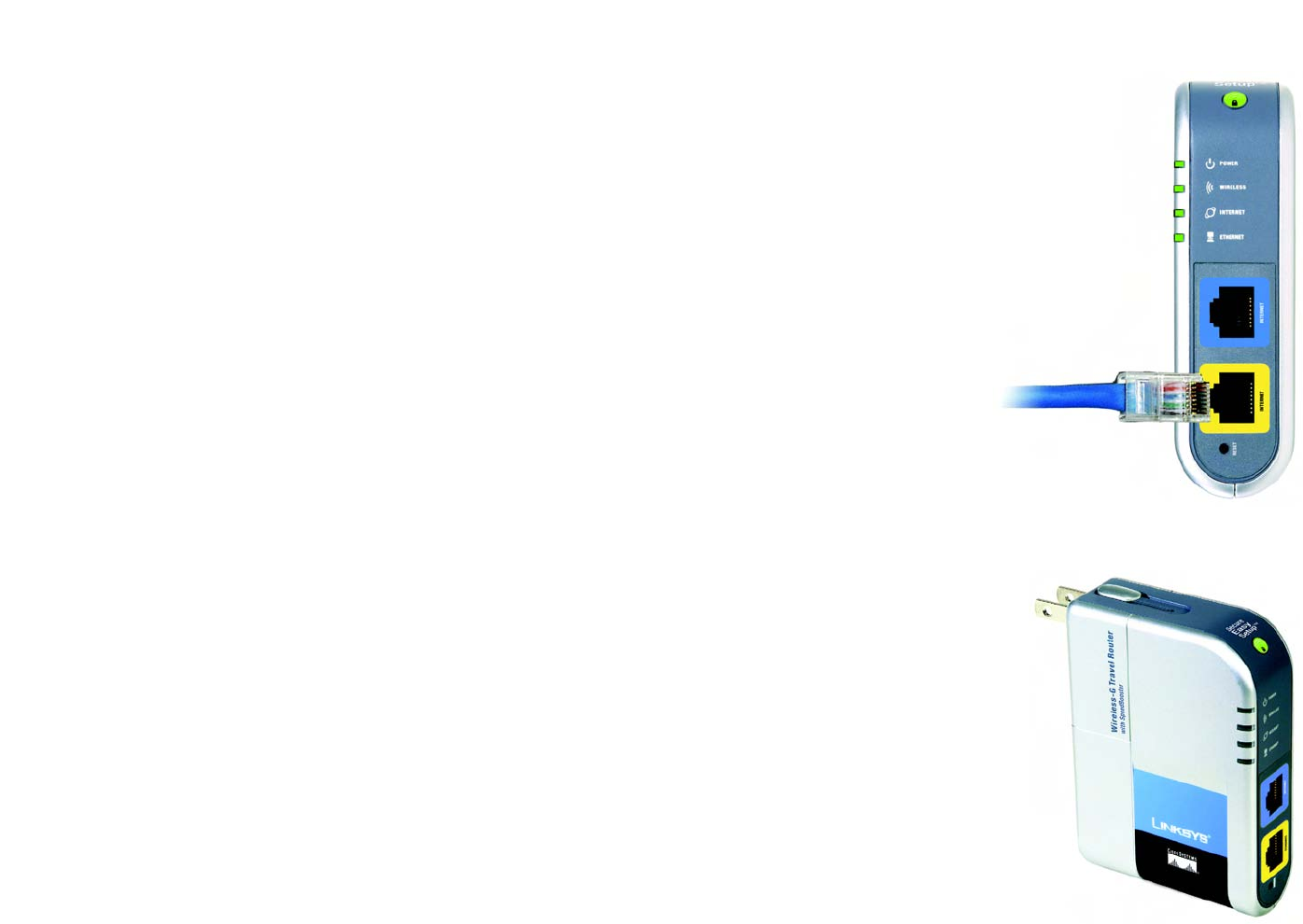
9
Chapter 4: Connecting the Wireless-G Travel Router with SpeedBooster
Hardware Installation
Wireless-G Travel Router with SpeedBooster
3. For setup or if using a wired connection, connect a standard Ethernet network cable from the Router’s
Ethernet port to your PC.
4. Slide the Power Slide until the Power Plug is fully extended. Then, plug the Power Plug to an electrical outlet.
Now that the hardware installation is complete, proceed to “Chapter 5: Configuring the Wireless-G Travel
Router with SpeedBooster.”
Figure 4-3: Connecting the Power
Figure 4-2: Connecting to the PC

10
Chapter 5: Configuring the Wireless-G Travel Router with SpeedBooster
Overview
Wireless-G Travel Router with SpeedBooster
Chapter 5: Configuring the Wireless-G Travel Router
with SpeedBooster
Overview
Linksys recommends using the Setup Wizard on the Setup CD-ROM for first-time installation of the Router. For
advanced users, you may follow the instructions in the previous chapter, “Chapter 4: Connecting the Wireless-G
Travel Router with SpeedBooster”, and then configure the Router through its Web-based Utility.
This chapter will describe each web page in the Utility and each page’s key functions. The utility can be accessed
via your web browser through use of a computer connected to the Router. For a basic network setup, most users
will use these two screens of the Utility:
• Basic Setup. On the Basic Setup screen, enter the settings provided by your ISP.
• Management. Click the Administration tab and then the Management tab. The Router’s default password is
admin. To secure the Router, change the Password from its default.
There are seven main tabs: Setup, Wireless, Security, Access Restrictions, Applications & Gaming, Administration,
and Status. Additional tabs will be available after you click one of the main tabs.
Make the necessary changes through the Web-based Utility. On each screen, click the Save Settings button to
apply your changes or Cancel Changes to cancel your changes. Help information is shown on the right-hand side
of the screen.
HAVE YOU: Enabled TCP/IP on your PCs? PCs
communicate over the network with this protocol.
Refer to “Appendix D: Windows Help” for more
information on TCP/IP.
NOTE: For first-time installation of the Router,
Linksys recommends using the Setup Wizard on the
Setup CD-ROM.
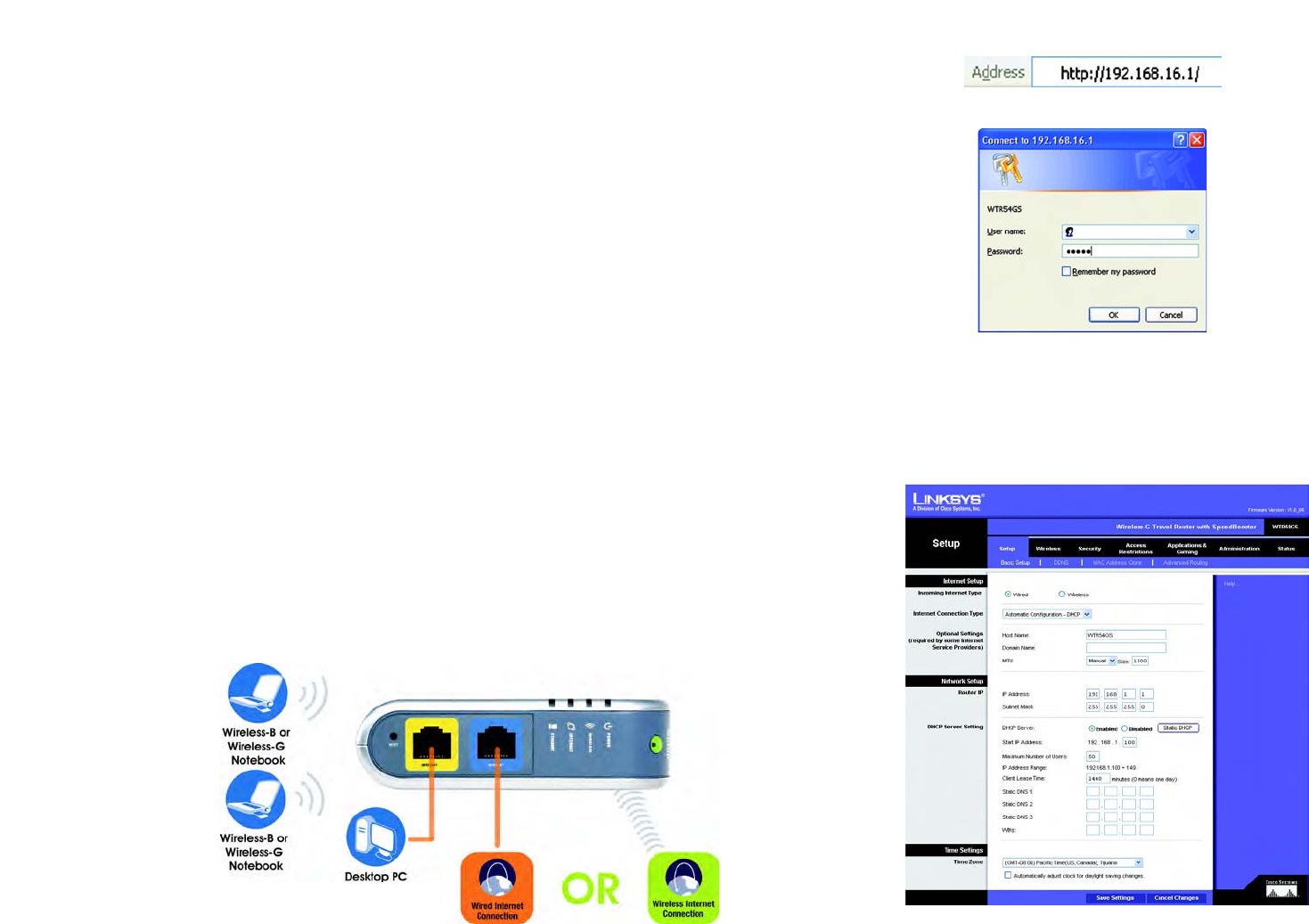
11
Chapter 5: Configuring the Wireless-G Travel Router with SpeedBooster
How to Access the Web-based Utility
Wireless-G Travel Router with SpeedBooster
How to Access the Web-based Utility
To access the Web-based Utility, launch Internet Explorer or Netscape Navigator, and enter the Router’s default IP
address, 192.168.16.1, in the Address field. Then press Enter.
A password request page will appear. Leave the User Name field blank. The first time you open the Web-based
Utility, use the default password admin. (You can set a new password from the Administration tab’s Management
screen.) Then click the OK button.
The Setup Tab - Basic Setup
The first screen that appears displays the Setup tab. This allows you to change the Router's general settings.
Internet Setup
The Internet Setup section configures the Router to your Internet connection. Most of this information can be
obtained from your ISP.
Incoming Internet Type
There are two options for Internet connection. You can use a wired connection or a wireless connection. The
wireless connection can be used as a single incoming wireless connection that others can share. Select the type
of connection you want to use, Wired or Wireless, then continue to the section for that option.
Figure 5-1: Router’s IP Address
Figure 5-2: Router Login Screen
ip (internet protocol): a protocol used to send data
over a network.
ip address: the address used to identify a computer
or device on a network.
Figure 5-3: Basic Setup

12
Chapter 5: Configuring the Wireless-G Travel Router with SpeedBooster
The Setup Tab - Basic Setup
Wireless-G Travel Router with SpeedBooster
Wireless Internet Type
Wireless Network. Select the network that you want to connect to from the list and click Select. Click the
Refresh button if your network does not appear.
Internet IP Address. Select your Internet connection type.
•Automatic Configuration - DHCP. By default, the Router’s Internet Connection Type is set to
Automatic Configuration - DHCP, which should be kept only if your ISP supports DHCP or you are
connecting through a dynamic IP address.
•Static IP. If you are required to use a permanent IP address to connect to the Internet, select Static IP.
Internet IP Address. This is the Router’s IP address, when seen from the Internet. Your ISP will provide
you with the IP Address you need to specify here.
Subnet Mask. This is the Router’s Subnet Mask, as seen by users on the Internet (including your ISP).
Your ISP will provide you with the Subnet Mask.
Default Gateway. Your ISP will provide you with the Gateway Address, which is the ISP server’s IP
address.
DNS (1-3). Your ISP will provide you with at least one DNS (Domain Name System) Server IP Address.
Wired Internet Type
Internet Connection Type
•Automatic Configuration - DHCP. By default, the Router’s Internet Connection Type is set to
Automatic Configuration - DHCP, which should be kept only if your ISP supports DHCP or you are
connecting through a dynamic IP address. Figure 5-5: Setup Tab - Basic Setup - DHCP Internet
Connection Type
Figure 5-4: Wireless Internet Type
IMPORTANT: You can only connect wirelessly to an open
access network. You cannot connect to a secured network.

13
Chapter 5: Configuring the Wireless-G Travel Router with SpeedBooster
The Setup Tab - Basic Setup
Wireless-G Travel Router with SpeedBooster
•Static IP. If you are required to use a permanent IP address to connect to the Internet, select Static IP.
Internet IP Address. This is the Router’s IP address, when seen from the Internet. Your ISP will provide
you with the IP Address you need to specify here.
Subnet Mask. This is the Router’s Subnet Mask, as seen by users on the Internet (including your ISP).
Your ISP will provide you with the Subnet Mask.
Default Gateway. Your ISP will provide you with the Gateway Address, which is the ISP server’s IP
address.
DNS (1-3). Your ISP will provide you with at least one DNS (Domain Name System) Server IP Address.
•PPPoE. Some DSL-based ISPs use PPPoE (Point-to-Point Protocol over Ethernet) to establish Internet
connections. If you are connected to the Internet through a DSL line, check with your ISP to see if they
use PPPoE. If they do, you will have to enable PPPoE.
User Name and Password. Enter the User Name and Password provided by your ISP.
Connect on Demand: Max Idle Time. You can configure the Router to cut the Internet connection after it
has been inactive for a specified period of time (Max Idle Time). If your Internet connection has been
terminated due to inactivity, Connect on Demand enables the Router to automatically re-establish your
connection as soon as you attempt to access the Internet again. If you wish to activate Connect on
Demand, click the radio button. In the Max Idle Time field, enter the number of minutes you want to
have elapsed before your Internet connection terminates.
Keep Alive: Redial Period. If you select this option, the Router will periodically check your Internet
connection. If you are disconnected, then the Router will automatically re-establish your connection. To
use this option, click the radio button next to Keep Alive. In the Redial Period field, you specify how
often you want the Router to check the Internet connection. The default Redial Period is 30 seconds.
•PPTP. Point-to-Point Tunneling Protocol (PPTP) is a service that applies to connections in Europe only.
Server IP Address. This is server’s IP address, as seen from the Internet. Your ISP will provide you with
the IP Address you need to specify here.
Local IP Address. This is the Router’s IP address, as seen from the Internet. Your ISP will provide you
with the IP Address you need to specify here.
Figure 5-7: PPPoE Connection Type
Figure 5-6: Static IP Connection Type
static ip address: a fixed address
assigned to a computer or device
connected to a network.
subnet mask: an address code that
determines the size of the network.
default gateway: a device that forwards
Internet traffic from your local area network.
pppoe: a type of broadband connection that
provides authentication (username and
password) in addition to data transport
packet: a unit of data sent over a network

14
Chapter 5: Configuring the Wireless-G Travel Router with SpeedBooster
The Setup Tab - Basic Setup
Wireless-G Travel Router with SpeedBooster
Connection ID/Name. This is the name of the connection.
Subnet Mask. This is the Router’s Subnet Mask, as seen by users on the Internet (including your ISP).
Your ISP will provide you with the Subnet Mask.
User Name and Password. Enter the User Name and Password provided by your ISP.
Connect on Demand: Max Idle Time. You can configure the Router to cut the Internet connection after it
has been inactive for a specified period of time (Max Idle Time). If your Internet connection has been
terminated due to inactivity, Connect on Demand enables the Router to automatically re-establish your
connection as soon as you attempt to access the Internet again. If you wish to activate Connect on
Demand, click the radio button. In the Max Idle Time field, enter the number of minutes you want to
have elapsed before your Internet connection terminates.
Keep Alive Option: Redial Period. If you select this option, the Router will periodically check your
Internet connection. If you are disconnected, then the Router will automatically re-establish your
connection. To use this option, click the radio button next to Keep Alive. In the Redial Period field, you
specify how often you want the Router to check the Internet connection. The default Redial Period is 30
seconds.
Optional Settings
Some of these settings may be required by your ISP. Verify with your ISP before making any changes.
Host Name and Domain Name. These fields allow you to supply a host and domain name for the
Router. Some ISPs, usually cable ISPs, require these names as identification. You may have to check
with your ISP to see if your broadband Internet service has been configured with a host and domain
name. In most cases, leaving these fields blank will work.
MTU. MTU is the Maximum Transmission Unit. It specifies the largest packet size permitted for Internet
transmission. Select Manual if you want to manually enter the largest packet size that will be
transmitted. The recommended size, entered in the Size field, is 1500. You should leave this value in the
1200 to 1500 range. To have the Router select the best MTU for your Internet connection, keep the
default setting, Auto.
Network Setup
The Network Setup section changes the Router’s local network settings. Changes to the Router’s wireless
network settings are performed through the Wireless tab.
Figure 5-8: PPTP Connection Type

15
Chapter 5: Configuring the Wireless-G Travel Router with SpeedBooster
The Setup Tab - Basic Setup
Wireless-G Travel Router with SpeedBooster
Router IP
IP Address and Subnet Mask. This shows both the Router’s IP Address and Subnet Mask, as seen by your
network. The default IP Address is 192.168.16.1, and the default Subnet Mask is 255.255.255.0. In most cases,
keeping the default values will work.
DHCP Server Setting
The settings allow you to configure the Router’s Dynamic Host Configuration Protocol (DHCP) server function. The
Router can be used as a DHCP server for your network. A DHCP server automatically assigns an IP address to
each computer on your network. If you choose to enable the Router’s DHCP server option, you must make sure
there is no other DHCP server on your network.
DHCP Server. DHCP is enabled by factory default. If you already have a DHCP server on your network, or you
don’t want a DHCP server, then select Disabled (no other DHCP features will be available).
Static DHCP. Every time a PC reboots, it is assigned a new local IP address by the Router. If you want a PC to be
assigned the same IP address every time it reboots, then click the Static IP button.
On the DHCP Client List screen, enter the static local IP address in the Assign this IP field, and enter the MAC
address of the PC in the To this MAC field. Then click the Enabled checkbox. When you have finished your entries,
click the Save Settings button to save your changes. Click the Cancel Changes button to cancel your changes.
To exit this screen, click the Close button.
If you want to see a list of DHCP clients, click the DHCP Client Table button. On the DHCP Client Table screen, you
will see a list of DHCP clients with the following information: Client Name, Interface, IP Addresse, and MAC
Addresse. To save the information, select Static DHCP Client List. From the To Sort by drop-down menu, you can
sort the table by Client Name, Interface, IP Address, or MAC Address. To view the most up-to-date information,
click the Refresh button. To exit this screen, click the Close button.
Start IP Address. Enter a value for the DHCP server to start with when issuing IP addresses. Because the
Router’s default IP address is 192.168.16.1, the Starting IP Address must be 192.168.1.2 or greater, but smaller
than 192.168.1.254. The default Starting IP Address is 192.168.16.100.
Maximum Number of Users. Enter the maximum number of PCs that you want the DHCP server to assign IP
addresses to. This number cannot be greater than 253. The default is 50.
IP Address Range. The range of DHCP addresses is displayed here.
Client Lease Time. The Client Lease Time is the amount of time a network user will be allowed connection to the
Router with their current dynamic IP address. Enter the amount of time, in minutes, that the user will be “leased”
Figure 5-9: Static DHCP Client List
Figure 5-10: DHCP Client Table

16
Chapter 5: Configuring the Wireless-G Travel Router with SpeedBooster
The Setup Tab - DDNS
Wireless-G Travel Router with SpeedBooster
this dynamic IP address. After the time is up, the user will be automatically assigned a new dynamic IP address.
The default is 0 minutes, which means one day.
Static DNS (1-3). Your ISP will provide you with at least one DNS (Domain Name System) Server IP Address.
WINS. The Windows Internet Naming Service (WINS) manages each PC’s interaction with the Internet. If you use
a WINS server, enter that server’s IP Address here. Otherwise, leave this blank.
Time Settings
Change the time zone in which your network functions from this pull-down menu. Click the checkbox if you want
the Router to automatically adjust for daylight savings time.
Change these settings as described here and click the Save Settings button to apply your changes or Cancel
Changes to cancel your changes. Help information is shown on the right-hand side of the screen.
The Setup Tab - DDNS
The Router offers a Dynamic Domain Name System (DDNS) feature. DDNS lets you assign a fixed host and domain
name to a dynamic Internet IP address. It is useful when you are hosting your own website, FTP server, or other
server behind the Router.
Before you can use this feature, you need to sign up for DDNS service at one of two DDNS service providers, DynDNS.org or
TZO.com. If you do not want to use this feature, keep the default setting, Disabled.
DDNS
DDNS Service. If your DDNS service is provided by DynDNS.org, then select DynDNS.org from the drop-down
menu. If your DDNS service is provided by TZO, then select TZO.com. The features available on the DDNS screen
will vary, depending on which DDNS service provider you use.
DynDNS.org
User Name, Password, and Host Name. Enter the User Name, Password, and Host Name of the account you
set up with DynDNS.org.
Internet IP Address. The Router’s current Internet IP Address is displayed here. Because it is dynamic, it will
change.
Status. The status of the DDNS service connection is displayed here.
dynamic ip address: a temporary IP
address assigned by a DHCP server.
Figure 5-11: DynDNS.org

17
Chapter 5: Configuring the Wireless-G Travel Router with SpeedBooster
The Setup Tab - MAC Address Clone
Wireless-G Travel Router with SpeedBooster
TZO.com
E-mail Address, TZO Password, and Domain Name. Enter the Email Address, Password, and Domain Name
of the service you set up with TZO.
Internet IP Address. The Router’s current Internet IP Address is displayed here. Because it is dynamic, this
will change.
Status. The status of the DDNS service connection is displayed here.
When you have finished making changes to this screen, click the Save Settings button to apply your changes or
Cancel Changes to cancel your changes. Help information is shown on the right-hand side of the screen.
The Setup Tab - MAC Address Clone
A MAC address is a 12-digit code assigned to a unique piece of hardware for identification. Some ISPs will
require you to register a MAC address in order to access the Internet. If you do not wish to re-register the MAC
address with your ISP, you may assign the MAC address you have currently registered with your ISP to the Router
with the MAC Address Clone feature.
MAC Address Clone
Enabled/Disabled. To have the MAC Address cloned, select Enabled from the drop-down menu.
MAC Address. Enter the MAC Address registered with your ISP here.
Clone My PC’s MAC. Clicking this button will clone the MAC address of the PC you are currently using.
Change these settings as described here and click the Save Settings button to apply your changes or Cancel
Changes to cancel your changes. Help information is shown on the right-hand side of the screen.
Figure 5-13: Setup Tab - MAC Address Clone
mac address: the unique address that a
manufacturer assigns to each networking device.
Figure 5-12: TZO.com

18
Chapter 5: Configuring the Wireless-G Travel Router with SpeedBooster
The Setup Tab - Advanced Routing
Wireless-G Travel Router with SpeedBooster
The Setup Tab - Advanced Routing
This tab is used to set up the Router’s advanced functions. Operating Mode allows you to select the type(s) of
advanced functions you use. Dynamic Routing will automatically adjust how packets travel on your network. Static
Routing sets up a fixed route to another network destination.
NAT (Network Address Translation). NAT technology translates IP addresses of a local area network to a
different IP address for the Internet. To enable NAT, click Enabled. To disable NAT, click Disabled.
Dynamic Routing (RIP)
. This feature enables the Router to automatically adjust to physical changes in the
network’s layout and exchange routing tables with the other router(s). The Router determines the network packets’
route based on the fewest number of hops between the source and the destination. This feature is
Disabled
by
default.
Static Routing
. A static route is a pre-determined pathway that network information must travel to reach a specific
host or network. To set up a static route between the Router and another network, enter the information described
below to set up a new static route by clicking the
Add New Entry
button to add an entry. Click the
Update Selected
Entry
button to change an existing entry. (Click the
Delete
button to delete a static route.)
Destination LAN IP
. The Destination LAN IP is the address of the remote network or host to which you want to
assign a static route.
Enter the IP address of the host for which you wish to create a static route. If you are
building a route to an entire network, be sure that the network portion of the IP address is set to 0. For
example, the Router’s standard IP address is 192.168.16.1. Based on this address, the address of the routed
network is 192.168.16, with the last digit determining the Router’s place on the network. Therefore you would
enter the IP address 192.168.16.0 if you wanted to route to the Router’s entire network, rather than just to the
Router.
Subnet Mask
. The Subnet Mask determines which portion of a Destination LAN IP address is the network
portion, and which portion is the host portion.
For example, a network may have the Subnet Mask of
255.255.255.0. This determines (by using the values 255) that the first three numbers of a network IP address
identify this particular network, while the last digit (from 1 to 254) identifies the specific host.
Default Gateway
. This is the IP address of the gateway device that allows for contact between the Router and
the remote network or host.
Interface
. This interface tells you whether the Destination IP Address is on the
LAN & Wireless
(Ethernet and
wireless networks) or the
Internet
(WAN). From the drop-down menu, you can also select
LAN & Wireless
, which
performs dynamic routing over your Ethernet and wireless networks. You can also select
WAN
, which performs
dynamic routing with data coming from the Internet. Finally, selecting
Both
enables dynamic routing for both
networks, as well as data from the Internet.
Figure 5-14: Setup Tab - Advanced Routing
Figure 5-15: Setup Tab - Advanced Routing - Routing
Table

19
Chapter 5: Configuring the Wireless-G Travel Router with SpeedBooster
The Wireless Tab - Basic Wireless Settings
Wireless-G Travel Router with SpeedBooster
Metric. This determines the maximum number of steps between network nodes that data packets will travel.
A node is any device on the network, such as PCs, print servers, routers, etc.
Click the
Show Routing Table
button to view the Static Routes you’ve already set up.
Show Routing Table. For
each route, the Destination (LAN IP address), (Subnet) Mask, (Default) Gateway, and Metric are displayed. Click
the Refresh button to update the information. Click the Close button to close the table.
Change these settings as described here and click the
Save Settings
button to apply your changes or
Cancel
Changes
to cancel your changes.
The Wireless Tab - Basic Wireless Settings
The basic settings for wireless networking are set on this screen.
Basic Wireless Settings
Wireless. To use your Router’s wireless connection, click Enabled. To disable your connection, click Disabled.
Network Mode. From this drop-down menu, you can select the wireless standards running on your network. If
you have both 802.11g and 802.11b devices in your network, keep the default setting, Mixed. If you have only
802.11g devices, select Wireless-G Only. If you have only 802.11b devices, select Wireless-B Only.
Network Name (SSID). The SSID is the network name shared by all devices in a wireless network. The SSID
must be identical for all devices in the wireless network. It is case-sensitive and must not exceed 32 keyboard
characters in length. Make sure this setting is the same for all devices in your wireless network. For added
security, you should change the default SSID (linksys) to a unique name.
Channel. Select the appropriate channel from the list provided to correspond with your network settings. All
devices in your wireless network must broadcast on the same channel in order to communicate.
SSID Broadcast. When wireless clients survey the local area for wireless networks to associate with, they will
detect the SSID broadcast by the Router. To broadcast the Router's SSID, keep the default setting, Enabled. If you
do not want to broadcast the Router's SSID, then select Disabled.
Encryption. The wireless security used on your wireless network is displayed here.
Figure 5-16: Wireless Tab - Basic Wireless Settings

20
Chapter 5: Configuring the Wireless-G Travel Router with SpeedBooster
The Wireless Tab - Basic Wireless Settings
Wireless-G Travel Router with SpeedBooster
SecureEasySetup Button. The status of the Router’s SecureEasySetup feature is displayed here. If you want to
use the SecureEasySetup feature, click the SecureEasySetup button.
You will be asked to press the SecureEasySetup button (hardware or software) on your wireless client (computer
or other network device) within two minutes to complete the SecureEasySetup process. Click the OK button to
continue.
A new screen will be displayed while the Router is waiting for you to push the SecureEasySetup button on your
wireless client.
When the SecureEasySetup process is complete, the Basic Wireless Settings screen will appear, and the Current
Encryption and Status information will be updated.
Status. The status of your wireless security is displayed here.
Reset Security. If you already set up the network using the SecureEasySetup feature and you want to replace
your current settings with new SecureEasySetup settings, click the Reset Security button. A new screen will
appear. You will be asked to confirm that you want to reset your wireless security settings. Click the OK button to
continue.
The Router will generate a new network name (SSID) and set of keys.
Change these settings as described here and click the Save Settings button to apply your changes or Cancel
Changes to cancel your changes. Help information is shown on the right-hand side of the screen.

21
Chapter 5: Configuring the Wireless-G Travel Router with SpeedBooster
The Wireless Tab - Wireless Security
Wireless-G Travel Router with SpeedBooster
The Wireless Tab - Wireless Security
The Wireless Security settings configure the security of your wireless network. There are three wireless security
mode options supported by the Router: WPA Personal, WPA2-Personal, WPA2-Mixed, and WEP. (WEP stands for
Wired Equivalent Privacy). These four are briefly discussed here. For detailed instructions on configuring wireless
security for the Router, turn to “Appendix B: Wireless Security.”
When finished making your changes on this tab, click the Save Settings button to save these changes, or click
the Cancel Changes button to undo your changes.
Wireless Security
WEP. WEP is a basic encryption method. Select a level of WEP encryption, 40/64-bit Hex digits or 128-bit Hex
digits. If you want to use a Passphrase, then enter it in the Passphrase field and click the Generate button. If you
want to enter the WEP key manually, then enter it in the WEP Key 1-4 field(s). To indicate which WEP key to use,
select the appropriate TX Key number.
• Passphrase. Instead of manually entering WEP keys, you can enter a passphrase. It is used to generate one or
more WEP keys. It is case-sensitive and should not be longer than 32 alphanumeric characters. (This
Passphrase function is compatible with Linksys wireless products only. If you want to communicate with non-
Linksys wireless products, make a note of the WEP key generated in the Key 1 field, and enter it manually in
the wireless client.) After you enter the Passphrase, click the Generate button to create WEP keys.
• TX Key Select which WEP key (1-4) will be used when the Router sends data. Make sure that the receiving
device (wireless client) is using the same key.
• WEP Keys 1-4. WEP keys enable you to create an encryption scheme for wireless network transmissions. If
you are not using a Passphrase, then manually enter a set of values. (Do not leave a key field blank, and do
not enter all zeroes; they are not valid key values.) If you are using 64-bit WEP encryption, the key must be
exactly 10 hexadecimal characters in length. If you are using 128-bit WEP encryption, the key must be exactly
26 hexadecimal characters in length. Valid hexadecimal characters are “0”-“9” and “A”-“F”.
WPA-Personal. This method offers two encryption methods, TKIP and AES, with dynamic encryption keys. Select
the type of encryption method you want to use, TKIP or AES. Enter the Passphrase, which can have 8 to 63
characters. Then enter the Key Renewal period, which instructs the Router how often it should change the
encryption keys.
Figure 5-17: Wireless Tab - Wireless Security
(WEP)
Figure 5-18: Wireless Tab - Wireless Security
(WPA Personal)
wep (wired equivalent privacy): a method of
encrypting network data transmitted on a
wireless network for greater security.
IMPORTANT: If you are using encryption,
always remember that each device in your
wireless network MUST use the same
encryption method and encryption key, or
else your wireless network will not function
properly.

22
Chapter 5: Configuring the Wireless-G Travel Router with SpeedBooster
The Wireless Tab - Wireless Security
Wireless-G Travel Router with SpeedBooster
Figure 5-20: Wireless Tab - Wireless Security (WPA2-Mixed)
WPA2-Personal. WPA2-Personal gives you one encryption method, AES, with dynamic encryption keys. Enter a
Passphrase of 8-63 characters. Then enter a Key Renewal period, which instructs the Router how often it should
change the encryption keys.
WPA2-Mixed. WPA2-Mixed gives you TKIP+AES encryption. Enter a Passphrase of 8-63 characters. Then enter a
Key Renewal period, which instructs the Router how often it should change the encryption keys.
Figure 5-19: Wireless Tab - Wireless Security
(WPA2-Personal)

23
Chapter 5: Configuring the Wireless-G Travel Router with SpeedBooster
The Wireless Tab - Wireless MAC Filter
Wireless-G Travel Router with SpeedBooster
The Wireless Tab - Wireless MAC Filter
Wireless access can be filtered by using the MAC addresses of the wireless devices transmitting within your
network’s radius.
Wireless MAC Filter
To filter wireless users by MAC Address, either permitting or blocking access, click Enabled. If you do not wish to
filter users by MAC Address, select Disabled.
Access Restriction
Prevent ONLY PCs listed below to access the wireless network. Clicking this radio button will block wireless
access by MAC Address.
Permit ONLY PCs listed below to access the wireless network. Clicking this radio button will allow wireless
access by MAC Address.
Wireless Client List
Wireless Client List. Click the Wireless Client MAC List button to display a list of network users by MAC
Address. From the To Sort by drop-down menu, you can sort the table by Client Name, IP Address, MAC Address,
or Expires. To view the most up-to-date information, click the Refresh button. To exit this screen, click the Close
button.
Change these settings as described here and click the Save Settings button to apply your changes or Cancel
Changes to cancel your changes. Help information is shown on the right-hand side of the screen.
Figure 5-21: Wireless Tab - Wireless MAC Filter
Figure 5-22: Wireless Tab - Wireless Client List

24
Chapter 5: Configuring the Wireless-G Travel Router with SpeedBooster
The Wireless Tab - Advanced Wireless Settings
Wireless-G Travel Router with SpeedBooster
The Wireless Tab - Advanced Wireless Settings
This tab is used to set up the Router’s advanced wireless functions. These settings should only be adjusted by an
expert administrator as incorrect settings can reduce wireless performance.
Advanced Wireless
Frame Burst Mode. Enabling this option should provide your network with greater performance, depending on
the manufacturer of your wireless products. If you are not sure how to use this option, keep the default, Enabled
(Default).
AP Isolation. This isolates all wireless clients and wireless devices on your network from each other. Wireless
devices will be able to communicate with the Router but not with each other. To use this function, click Enabled.
AP Isolation is disabled by default.
Authentication Type. The default is set to Open System, allows either Open System or Shared Key
authentication to be used. With Open System authentication, the sender and the recipient do NOT use a WEP key
for authentication. With Shared Key authentication, the sender and recipient use a WEP key for authentication.
Basic Rate. The Basic Rate setting is not actually one rate of transmission but a series of rates at which the
Router can transmit. The Router will advertise its Basic Rate to the other wireless devices in your network, so
they know which rates will be used. The Router will also advertise that it will automatically select the best rate
for transmission. The default setting is Default, when the Router can transmit at all standard wireless rates
(1-2Mbps, 5.5Mbps, 11Mbps, 18Mbps, and 24Mbps). Other options are 1-2Mbps, for use with older wireless
technology, and All, when the Router can transmit at all wireless rates. The Basic Rate is not the actual rate of
data transmission. If you want to specify the Router’s rate of data transmission, configure the Transmission Rate
setting.
Transmission Rate. The rate of data transmission should be set depending on the speed of your wireless
network. You can select from a range of transmission speeds, or you can select Auto (Default) to have the
Router automatically use the fastest possible data rate and enable the Auto-Fallback feature. Auto-Fallback will
negotiate the best possible connection speed between the Router and a wireless client. The default value is Auto
(Default).
CTS Protection Mode. CTS (Clear-To-Send) Protection Mode should be set to Auto (Default). The Router will
automatically use CTS Protection Mode when your Wireless-G products are experiencing severe problems and
are not able to transmit to the Router in an environment with heavy 802.11b traffic. This function boosts the
Router’s ability to catch all Wireless-G transmissions but will severely decrease performance.
Beacon Interval. The default value is 100. The Beacon Interval value indicates the frequency interval of the
beacon. A beacon is a packet broadcast by the Router to synchronize the wireless network.
Figure 5-23: Wireless Tab - Advanced Wireless
Settings
cts (clear to send): a signal sent by a wireless
device, signifying that it is ready to receive data.
dtim: a message included in data packets
that can increase wireless efficiency.

25
Chapter 5: Configuring the Wireless-G Travel Router with SpeedBooster
The Wireless Tab - Advanced Wireless Settings
Wireless-G Travel Router with SpeedBooster
DTIM Interval. This value indicates the interval of the Delivery Traffic Indication Message (DTIM). A DTIM field is
a countdown field informing clients of the next window for listening to broadcast and multicast messages. When
the Router has buffered broadcast or multicast messages for associated clients, it sends the next DTIM with a
DTIM Interval value. Its clients hear the beacons and awaken to receive the broadcast and multicast messages.
The default value is 1.
Fragmentation Threshold. This value specifies the maximum size for a packet before data is fragmented into
multiple packets. If you experience a high packet error rate, you may slightly increase the Fragmentation
Threshold. Setting the Fragmentation Threshold too low may result in poor network performance. Only minor
reduction of the default value is recommended. In most cases, it should remain at its default value of 2346.
RTS Threshold. Should you encounter inconsistent data flow, only minor reduction of the default value, 2347, is
recommended. If a network packet is smaller than the preset RTS threshold size, the RTS/CTS mechanism will
not be enabled. The Router sends Request to Send (RTS) frames to a particular receiving station and negotiates
the sending of a data frame. After receiving an RTS, the wireless station responds with a Clear to Send (CTS)
frame to acknowledge the right to begin transmission. The RTS Threshold value should remain at its default value
of 2347.
Change these settings as described here and click the Save Settings button to apply your changes or Cancel
Changes to cancel your changes. Help information is shown on the right-hand side of the screen.
beacon interval: data transmitted on your wireless
network that keeps the network synchronized.
fragmentation: breaking a packet into smaller units
when transmitting over a network medium that
cannot support the original size of the packet.

26
Chapter 5: Configuring the Wireless-G Travel Router with SpeedBooster
The Security Tab - Firewall
Wireless-G Travel Router with SpeedBooster
The Security Tab - Firewall
The Firewall screen offers Filters and the option to Block WAN Requests. Filters block specific Internet data types
and block anonymous Internet requests. To enable a feature, select Enabled from the drop-down menu. To
disable a feature, select Disabled from the drop-down menu.
Firewall
• SPI Firewall Protection. Enable this feature to employ Stateful Packet Inspection (SPI) for more detailed
review of data packets entering your network environment.
• Filter Anonymous Internet Requests. When enabled, this feature keeps your network from being “pinged,” or
detected, by other Internet users. It also reinforces your network security by hiding your network ports. Both
functions of this feature make it more difficult for outside users to work their way into your network. This
feature is enabled by default. Select Disabled to allow anonymous Internet requests.
• Filter Multicast. Multicasting allows for multiple transmissions to specific recipients at the same time. If
multicasting is permitted, then the Router will allow IP multicast packets to be forwarded to the appropriate
computers. Select Enable to filter multicasting, or Disable to disable this feature.
• Filter Internet NAT Redirection. This feature uses port forwarding to block access to local servers from local
networked computers. Check the box to enable filter Internet NAT redirection, or uncheck the box to disable
this feature.
• Web Filters
Proxy. Use of WAN proxy servers may compromise the Gateway's security. Denying Filter Proxy will disable
access to any WAN proxy servers. To enable proxy filtering, click the checkbox.
Java. Java is a programming language for websites. If you deny Java, you run the risk of not having access to
Internet sites created using this programming language. To enable Java filtering, click the checkbox.
ActiveX. ActiveX is a programming language for websites. If you deny ActiveX, you run the risk of not having
access to Internet sites created using this programming language. To enable ActiveX filtering, click the
checkbox.
Cookies. A cookie is data stored on your computer and used by Internet sites when you interact with them. To
enable cookie filtering, click the checkbox.
Change these settings as described here and click the Save Settings button to apply your changes or Cancel
Changes to cancel your changes. Help information is shown on the right-hand side of the screen.
Figure 5-24: Security Tab - Firewall

27
Chapter 5: Configuring the Wireless-G Travel Router with SpeedBooster
The Security Tab - VPN Passthrough
Wireless-G Travel Router with SpeedBooster
The Security Tab - VPN Passthrough
Use the settings on this tab to allow VPN tunnels using IPSec, L2TP, or PPTP protocols to pass through the
Router’s firewall.
VPN Passthrough
IPSec Passthrough. Internet Protocol Security (IPSec) is a suite of protocols used to implement secure exchange
of packets at the IP layer. IPSec Pass-Through is enabled by default. To disable IPSec Passthrough, select
Disabled.
L2TP Passthrough. Layer 2 Tunneling Protocol is the method used to enable Point-to-Point sessions via the
Internet on the Layer 2 level. L2TP Pass-Through is enabled by default. To disable L2TP Passthrough, select
Disabled.
PPTP Passthrough. Point-to-Point Tunneling Protocol (PPTP) allows the Point-to-Point Protocol (PPP) to be
tunneled through an IP network. PPTP Pass-Through is enabled by default. To disable PPTP Passthrough, select
Disabled.
Change these settings as described here and click the Save Settings button to apply your changes or Cancel
Changes to cancel your changes. Help information is shown on the right-hand side of the screen.
The Security Tab - VPN
Use the settings on this tab to create VPN tunnels. The Wireless-G Travel Router creates a tunnel or channel
between two endpoints, so that the data or information between these endpoints is secure.
VPN Tunnel
Establishing a Tunnel
The Router creates a tunnel or channel between two endpoints, so that the data or information between these
endpoints is secure. To establish this tunnel, select the tunnel you wish to create in the Select Tunnel Entry drop-
down menu. It is possible to create up to two simultaneous tunnels. To delete a tunnel, click the Delete button.
To view a summary of that tunnel, click the Summary button. The VPN Settings Summary screen displays the
number, name, local group, remote group, remote gateway, and security method.
Then check the box next to Enable to enable the tunnel. Once the tunnel is enabled, enter the name of the tunnel
in the Tunnel Name field. This is to allow you to identify multiple tunnels and does not have to match the name
used at the other end of the tunnel.
ipsec: a VPN protocol used to implement
secure exchange of packets at the IP layer.
pptp: a VPN protocol that allows the Point to Point
Protocol (PPP) to be tunneled through an IP network.
This protocol is also used as a type of broadband
connection in Europe.
Figure 5-25: Security Tab - VPN Passthrough
Figure 5-26: Security Tab - VPN

28
Chapter 5: Configuring the Wireless-G Travel Router with SpeedBooster
The Security Tab - VPN
Wireless-G Travel Router with SpeedBooster
Local Secure Group and Remote Secure Group
A Local Secure Group is a computer(s) on your network that can access the tunnel. A Remote Secure Group is a
computer (s) on the remote end of the tunnel that can access the tunnel. Under Local Secure Group and Remote
Secure Group, you may choose one of three options: Subnet, IP Address, and IP Range. Under Remote Secure
Group, you have two additional options: Host and Any.
Subnet. If you select Subnet (which is also the default), this will allow all computers on the local subnet to
access the tunnel. When using the Subnet setting, the default values of 0 should remain in the last fields of
the IP and Mask settings.
IP Address. If you select IP Address, only the computer with the specific IP Address that you enter will be
able to access the tunnel.
IP Range. If you select IP Range, it will be a combination of Subnet and IP Address. You can specify a range
of IP Addresses within the Subnet which will have access to the tunnel.
The next to options are for Remote Secure Groups only.
Host. If you select Host for the Remote Secure Group, then the Remote Secure Group will be the same as the
Remote Security Gateway setting: IP Address, FQDN (Fully Qualified Domain Name), or Any.
Any. If you select Any for the Remote Security Group, the local VPN Router will accept a request from any IP
address. This setting should be chosen when the other endpoint is using DHCP or PPPoE on the Internet side.
Remote Security Gateway
The Remote Security Gateway is the VPN device, such as a second VPN Router, on the remote end of the VPN
tunnel. Under Remote Security Gateway, you have three options: IP Address, FQDN, and Any. In this section, you
can also set the levels and types of encryption and authentication.
IP Address. If you select IP Address, enter the IP Address of the VPN device at the other end of the tunnel.
The remote VPN device can be another VPN Router, a VPN Server, or a computer with VPN client software that
supports IPSec. The IP Address may either be static (permanent) or dynamic (changing), depending on the
settings of the remote VPN device. Make sure that you have entered the IP Address correctly, or the
connection cannot be made. Remember, this is NOT the IP Address of the local VPN Router, but the IP Address
of the remote VPN Router or device with which you wish to communicate.
FQDN (Fully Qualified Domain Name). If you select FQDN, enter the FQDN of the VPN device at the other end of
the tunnel. The remote VPN device can be another VPN Router, a VPN Server, or a computer with VPN client
software that supports IPSec. The FQDN is the host name and domain name for a specific computer on the
Internet, for example, vpn.myvpnserver.com.
Figure 5-27: Security Tab - VPN - Summary

29
Chapter 5: Configuring the Wireless-G Travel Router with SpeedBooster
The Security Tab - VPN
Wireless-G Travel Router with SpeedBooster
Any. If you select Any for the Remote Security Gateway, the VPN device at the other end of the tunnel will
accept a request from any IP address. The remote VPN device can be another VPN Router, a VPN Server, or a
computer with VPN client software that supports IPSec. If the remote user has an unknown or dynamic IP
address (such as a professional on the road or a telecommuter using DHCP or PPPoE), then Any should be
selected.
Encryption. Using Encryption also helps make your connection more secure. There are two different types of
encryption: DES or 3DES (3DES is recommended because it is more secure). You may choose either of these,
but it must be the same type of encryption that is being used by the VPN device at the other end of the tunnel.
Or, you may choose not to encrypt by selecting Disable.
Authentication. Authentication acts as another level of security. There are two types of authentication: MD5
and SHA (SHA is recommended because it is more secure). As with encryption, either of these may be
selected, provided that the VPN device at the other end of the tunnel is using the same type of authentication.
Or, both ends of the tunnel may choose to Disable authentication.
Key Management
In order for any encryption to occur, the two ends of the tunnel must agree on the type of encryption and the way
the data will be decrypted. This is done by sharing a “key” to the encryption code. Under Key Management, you
may choose automatic or manual key management.
Automatic Key Management. Select Auto (IKE) and enter a series of numbers or letters in the Pre-shared
Key field. Check the box next to PFS (Perfect Forward Secrecy) to ensure that the initial key exchange and IKE
proposals are secure. In the example shown the word chappy is used. Based on this word, which MUST be
entered at both ends of the tunnel if this method is used, a key is generated to scramble (encrypt) the data
being transmitted over the tunnel, where it is unscrambled (decrypted). You may use any combination of up
to 24 numbers or letters in this field. No special characters or spaces are allowed. In the Key Lifetime field,
you may optionally select to have the key expire at the end of a time period of your choosing. Enter the
number of seconds you’d like the key to be useful, or leave it blank for the key to last indefinitely.
Manual Key Management. Similarly, you may choose Manual keying, which allows you to generate the key
yourself. Enter your key into the Encryption KEY field. Then enter an Authentication KEY into that field. These
fields must both match the information that is being entered in the fields at the other end of the tunnel. Up to
24 alphanumeric characters are allowed to create the Encryption Key. Up to 20 alphanumeric characters are
allowed to create the Authentication Key.
The Inbound SPI and Outbound SPI fields are different, however. The Inbound SPI value set here must match
the Outbound SPI value at the other end of the tunnel. The Outbound SPI here must match the Inbound SPI
value at the other end of the tunnel. That is, the Inbound SPI and Outbound SPI values would be opposite on
the other end of the tunnel. Only numbers can be used in these fields. After you click the Save Settings

30
Chapter 5: Configuring the Wireless-G Travel Router with SpeedBooster
The Security Tab - VPN
Wireless-G Travel Router with SpeedBooster
button, hexadecimal characters (series of letters and numbers) are displayed in the Inbound SPI and
Outbound SPI fields.
The Status field at the bottom of the screen will show when a tunnel is active.
To connect a VPN tunnel, click the Connect button. The View Logs button, when logging is enabled on the Log
screen of the Administration tab, will show you VPN activity on a separate screen. The VPN Log screen displays
successful connections, transmissions and receptions, and the types of encryption used. For more advanced VPN
options, click the Advanced Setting button to open the Advanced Setting screen.
When finished making your changes on this screen, click the Save Settings button to save these changes, or
click the Cancel Changes button to undo your changes.
Advanced VPN Tunnel Setup
From the Advanced Settings screen you can adjust the settings for specific VPN tunnels.
Phase 1
. Phase 1 is used to create a security association (SA), often called the IKE SA. After Phase 1 is completed, Phase
2 is used to create one or more IPSec SAs, which are then used to key IPSec sessions.
Operation Mode
. There are two modes: Main and Aggressive, and they exchange the same IKE payloads in different
sequences. Main mode is more common; however, some people prefer Aggressive mode because it is faster. Main mode
is for normal usage and includes more authentication requirements than Aggressive mode. Main mode is recommended
because it is more secure. No matter which mode is selected, the VPN Router will accept both Main and Aggressive
requests from the remote VPN device. If a user on one side of the tunnel is using a Unique Firewall Identifier, this should
be entered under the
Username
field.
Encryption
. Select the length of the key used to encrypt/decrypt ESP packets. There are two choices: DES and 3DES.
3DES is recommended because it is more secure.
Authentication
. Select the method used to authenticate ESP packets. There are two choices: MD5 and SHA. SHA is
recommended because it is more secure.
Group
. There are two Diffie-Hellman Groups to choose from: 768-bit and 1024-bit. Diffie-Hellman refers to a
cryptographic technique that uses public and private keys for encryption and decryption.
Key Lifetime
. In the Key Lifetime field, you may optionally select to have the key expire at the end of a time period of your
choosing. Enter the number of seconds you’d like the key to be used until a re-key negotiation between each endpoint is
completed.
Phase 2
Group
. There are two Diffie-Hellman Groups to choose from: 768-bit and 1024-bit. Diffie-Hellman refers to a
cryptographic technique that uses public and private keys for encryption and decryption.
Figure 5-28: Security Tab - VPN - Advanced VPN Tunnel
Setup

31
Chapter 5: Configuring the Wireless-G Travel Router with SpeedBooster
The Access Restrictions Tab - Internet Access Policy
Wireless-G Travel Router with SpeedBooster
Key Lifetime
. In the Key Lifetime field, you may optionally select to have the key expire at the end of a time period of your
choosing. Enter the number of seconds you’d like the key to be used until a re-key negotiation between each endpoint is
completed.
The Access Restrictions Tab - Internet Access Policy
The Internet Access Policy screen allows you to block or allow specific kinds of Internet usage and traffic, such as
Internet access, designated applications, websites, and inbound traffic during specific days and times.
Internet Access Policy
Access Policy. Access can be managed by a policy. Use the settings on this screen to establish an access policy
(after the Save Settings button is clicked). Selecting a policy from the drop-down menu will display that policy’s
settings. To delete a policy, select that policy’s number and click the Delete This Policy button. To view all the
policies, click the Summary button.
On the Summary screen, the policies are listed with the following information: No., Policy Name, Access, Days,
Time, and status (Enabled). You can change the type of access, days, and times of a policy. To activate a policy,
click the Enabled checkbox. To delete a policy, click its Delete button. Click the Save Settings button to save
your changes, or click the Cancel Changes button to cancel your changes. To return to the Internet Access Policy
tab, click the Close button. To view the list of PCs for a specific policy, click the PCs List button.
On the Internet Access PCs List screen, you can select a PC by MAC Address or IP Address. You can also enter a
range of IP Addresses if you want this policy to affect a group of PCs. After making your changes, click the Save
Settings button to apply your changes or Cancel Changes to cancel your changes. Click the Close button to exit
this screen.
To create an Internet Access policy:
1. Select a number from the Access Policy drop-down menu.
2. Enter a Policy Name in the field provided.
3. To enable this policy, select Enable from the Status drop-down menu.
4. Click the Edit List button to select which PCs will be affected by the policy. The Internet Access PCs List
screen will appear. You can select a PC by MAC Address or IP Address. You can also enter a range of IP
Addresses if you want this policy to affect a group of PCs. After making your changes, click the Save Settings
button to apply your changes or Cancel Changes to cancel your changes. Then click the Close button.
Figure 5-29: Access Restrictions Tab - Internet Access
Policy
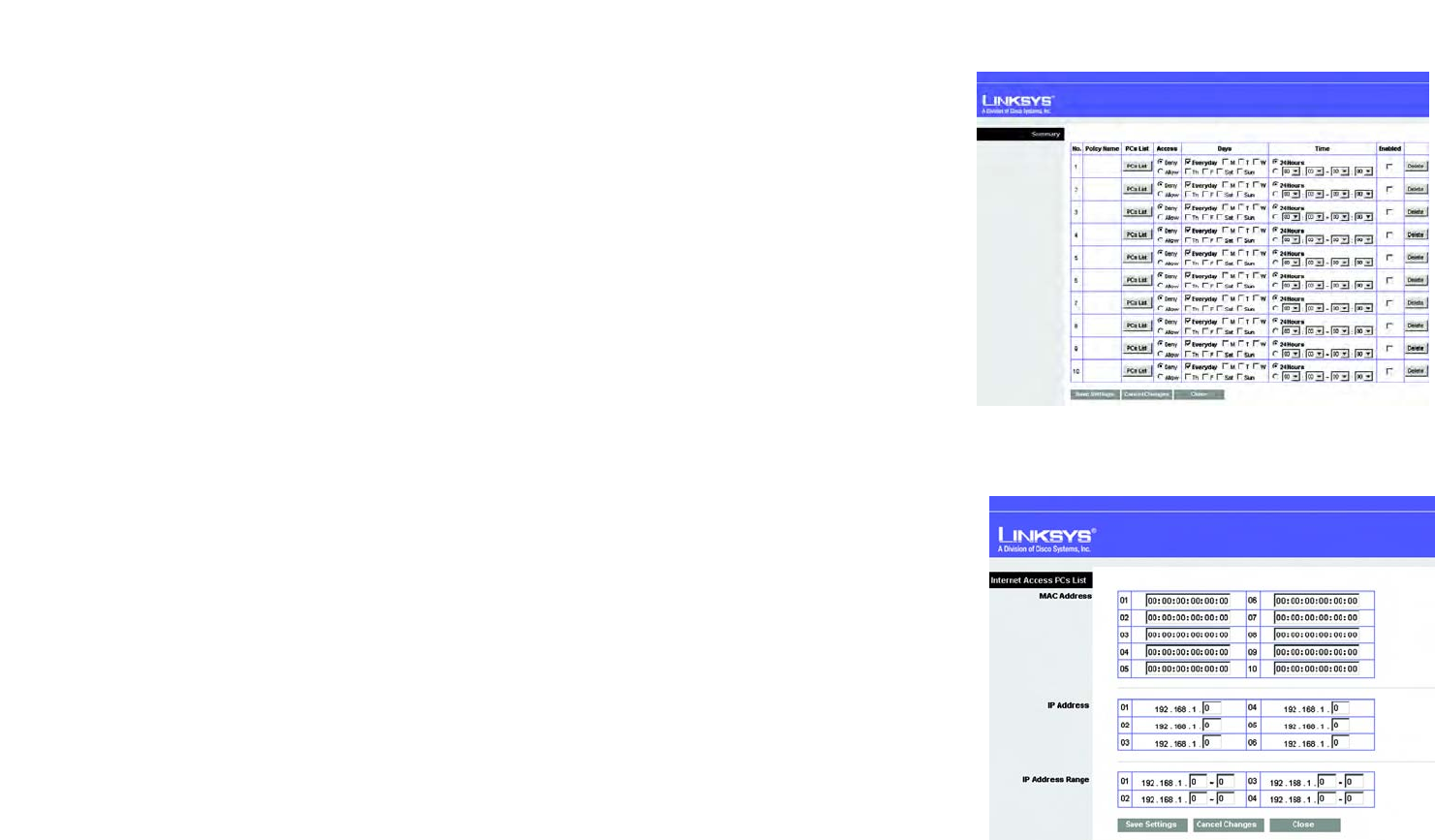
32
Chapter 5: Configuring the Wireless-G Travel Router with SpeedBooster
The Access Restrictions Tab - Internet Access Policy
Wireless-G Travel Router with SpeedBooster
Figure 5-30: Access Restrictions Tab - Summary
Figure 5-31: Access Restrictions Tab - Internet Access
PCs List
5. Click the appropriate option, Deny or Allow, depending on whether you want to block or allow Internet access
for the PCs you listed on the List of PCs screen.
6. Decide which days and what times you want this policy to be enforced. Select the individual days during
which the policy will be in effect, or select Everyday. Then enter a range of hours and minutes during which
the policy will be in effect, or select 24 Hours.
7. You can filter access to various applications accessed over the Internet, such as FTP or telnet, by selecting up
to three applications from the drop-down menus under Applications.
The Blocked List menu offers a choice of ten preset applications. For the preset applications you select, the
appropriate range of ports will automatically be displayed. Click the >> button to add to the Blocked Services
list.
If the application you want to block is not listed or you want to edit an application’s settings, then create a
new one by entering an Application Name, Port Range, and Protocol. Then, click Add.
8. You can also block access by URL address by entering it in the Website Blocking by URL Address field or by
Keyword by entering it in the Website Blocking by Keyword field.
9. Click the Save Settings button to save the policy’s settings. To cancel the policy’s settings, click the Cancel
Changes button.

33
Chapter 5: Configuring the Wireless-G Travel Router with SpeedBooster
The Applications and Gaming Tab - Port Range Forwarding
Wireless-G Travel Router with SpeedBooster
The Applications and Gaming Tab - Port Range Forwarding
The Port Range Forwarding screen allows you to set up public services on your network, such as web servers, ftp
servers, e-mail servers, or other specialized Internet applications. (Specialized Internet applications are any
applications that use Internet access to perform functions such as videoconferencing or online gaming. Some
Internet applications may not require any forwarding.)
Before using forwarding, you should assign static IP addresses to the designated PCs.
Port Range Forwarding
To forward a port, enter the information on each line for the criteria required. Descriptions of each criteria are
described here.
Application Name. Each drop-down menu offers a choice of ten preset applications (select None if you do not
want to use any of the preset applications). Select up to five preset applications. For custom applications, enter
the name of your application in one of the available fields.
The preset applications are among the most widely used Internet applications. They include the following:
DNS (Domain Name System). The way that Internet domain names are located and translated into IP addresses. A
domain name is a meaningful and easy-to-remember “handle” for an Internet address.
Finger. A UNIX command widely used on the Internet to find out information about a particular user, such as a
telephone number, whether the user is currently logged on, and the last time the user was logged on. The person
being “fingered” must have placed his or her profile on the system in order for the information to be available.
Fingering requires entering the full user@domain address.
FTP (File Transfer Protocol). A protocol used to transfer files over a TCP/IP network (Internet, UNIX, etc.). For
example, after developing the HTML pages for a website on a local machine, they are typically uploaded to the
web server using FTP.
POP3 (Post Office Protocol 3). A standard mail server commonly used on the Internet. It provides a message store
that holds incoming e-mail until users log on and download it. POP3 is a simple system with little selectivity. All
pending messages and attachments are downloaded at the same time. POP3 uses the SMTP messaging protocol.
SMTP (Simple Mail Transfer Protocol). The standard e-mail protocol on the Internet. It is a TCP/IP protocol that
defines the message format and the message transfer agent (MTA), which stores and forwards the mail.
tcp: a network protocol for transmitting data
that requires acknowledgement from the
recipient of data sent.
udp: a network protocol for transmitting data
that does not require acknowledgement from
the recipient of the data that is sent.
Figure 5-32: Applications and Gaming Tab - Port
Range Forwarding

34
Chapter 5: Configuring the Wireless-G Travel Router with SpeedBooster
The Applications and Gaming Tab - Port Range Forwarding
Wireless-G Travel Router with SpeedBooster
SNMP (Simple Network Management Protocol). A widely used network monitoring and control protocol. Data is
passed from SNMP agents, which are hardware and/or software processes reporting activity in each network
device (hub, router, bridge, etc.) to the workstation console used to oversee the network. The agents return
information contained in a MIB (Management Information Base), which is a data structure that defines what is
obtainable from the device and what can be controlled (turned off, on, etc.).
Telnet. A terminal emulation protocol commonly used on Internet and TCP/IP-based networks. It allows a user at
a terminal or computer to log onto a remote device and run a program.
TFTP (Trivial File Transfer Protocol). A version of the TCP/IP FTP protocol that has no directory or password
capability.
Web. The Internet.
Start/End Port. This is the port range. Enter the port number or range of external ports used by the server or
Internet application. Check with the software documentation of the Internet application for more information.
Protocol. Select the protocol(s) used for this application, TCP and/or UDP.
To IP Address. For each application, enter the IP address of the PC running the specific application.
Enabled. Click the Enabled checkbox to enable port forwarding for the relevant application.
Change these settings as described here and click the Save Settings button to apply your changes or Cancel
Changes to cancel your changes. Help information is shown on the right-hand side of the screen.

35
Chapter 5: Configuring the Wireless-G Travel Router with SpeedBooster
The Applications & Gaming Tab - Port Range Triggering
Wireless-G Travel Router with SpeedBooster
The Applications & Gaming Tab - Port Range Triggering
The Port Range Triggering screen allows the Router to watch outgoing data for specific port numbers. The IP
address of the computer that sends the matching data is remembered by the Router, so that when the requested
data returns through the Router, the data is pulled back to the proper computer by way of IP address and port
mapping rules.
Port Range Triggering
Application Name. Enter the application name of the trigger.
Triggered Range. For each application, list the triggered port number range. Check with the Internet application
documentation for the port number(s) needed. In the first field, enter the starting port number of the Triggered
Range. In the second field, enter the ending port number of the Triggered Range.
Forwarded Range. For each application, list the forwarded port number range. Check with the Internet
application documentation for the port number(s) needed. In the first field, enter the starting port number of the
Forwarded Range. In the second field, enter the ending port number of the Forwarded Range.
Enabled. Click the Enabled checkbox to enable port range triggering for the relevant application.
Change these settings as described here and click the Save Settings button to apply your changes or Cancel
Changes to cancel your changes. Help information is shown on the right-hand side of the screen.
Figure 5-33: Applications and Gaming Tab -
Port Range Triggering

36
Chapter 5: Configuring the Wireless-G Travel Router with SpeedBooster
The Applications and Gaming Tab - DMZ
Wireless-G Travel Router with SpeedBooster
The Applications and Gaming Tab - DMZ
The DMZ feature allows one network user to be exposed to the Internet for use of a special-purpose service such
as Internet gaming or videoconferencing. DMZ hosting forwards all the ports at the same time to one PC. The Port
Range Forwarding feature is more secure because it only opens the ports you want to have opened, while DMZ
hosting opens all the ports of one computer, exposing the computer to the Internet.
Any PC whose port is being forwarded must have its DHCP client function disabled and should have a new static
IP address assigned to it because its IP address may change when using the DHCP function.
DMZ
To expose one PC, select Enabled, then enter a WAN IP Address or Host IP Address in the field.
Wan IP Address. The Internet IP address of the computer you want to expose.
Host IP Address. Enter the IP address of the computer you want to expose.
Change these settings as described here and click the Save Settings button to apply your changes or Cancel
Changes to cancel your changes. Help information is shown on the right-hand side of the screen.
Figure 5-34: Applications and Gaming Tab - DMZ

37
Chapter 5: Configuring the Wireless-G Travel Router with SpeedBooster
The Administration Tab - Management
Wireless-G Travel Router with SpeedBooster
The Administration Tab - Management
This section of the Administration tab allows the network’s administrator to manage specific Router functions for
access and security.
Management
Router Access
Router Password and Re-enter to Confirm. You can change the Router’s password from here. Enter a new
Router password and then type it again in the Re-enter to Confirm field to confirm.
Remote Access
Remote Management. To access the Router remotely, from outside the local network, select Enabled.
Otherwise, keep the default setting, Disabled.
Remote Upgrade. If you want to be able to upgrade the Router remotely, from outside the local network, select
Enabled. (You must have the Remote Management feature enabled as well.) Otherwise, keep the default setting,
Disabled.
Allow Remote IP Address. If you want to be able to access the Router from any external IP address, select Any
IP Address. If you want to specify an external IP address or range of IP addresses, then select the second option
and complete the fields provided.
Remote Management Port. Enter the port number that will be open to outside access.
UPnP
Universal Plug and Play (UPnP) allows Windows Me and XP to automatically configure the Router for various
Internet applications, such as gaming and videoconferencing.
UPnP. If you want to use UPnP, keep the default setting, Enabled. Otherwise, select Disabled.
Allow Users to Configure. Keep the default setting, Enabled, if you want to be able to make manual changes to
the Router while using the UPnP feature. Otherwise, select Disabled.
Allow Users to Disable Internet Access. Keep the default setting, Enabled, if you want to be able to prohibit
any and all Internet connections. Otherwise, select Disabled.
Figure 5-35: Administration Tab - Management

38
Chapter 5: Configuring the Wireless-G Travel Router with SpeedBooster
The Administration Tab - Management
Wireless-G Travel Router with SpeedBooster
Backup and Restore
Backup Configurations. To back up the Router’s configuration, click this button and follow the on-screen
instructions.
Restore Configurations. To restore the Router’s configuration, click this button and follow the on-screen
instructions. (You must have previously backed up the Router’s configuration.)
Change these settings as described here and click the Save Settings button to apply your changes or Cancel
Changes to cancel your changes. Help information is shown on the right-hand side of the screen.

39
Chapter 5: Configuring the Wireless-G Travel Router with SpeedBooster
The Administration Tab - Log
Wireless-G Travel Router with SpeedBooster
The Administration Tab - Log
The Router can keep logs of all traffic for your Internet connection.
Log
The Router can keep logs of all traffic for your Internet connection. To disable the Log function, keep the default
setting, Disable. To monitor traffic between the network and the Internet, select Enable. When you wish to view
the logs, click the View Log button, then select Incoming Log, Outgoing Log, Security Log, DHCP Client Log,
or VPN Log from the Type drop-down menu.
The Incoming Log will display a temporary log of the Source IP Addresses and Destination Port Numbers for the
incoming Internet traffic.
The Outgoing Log will display a temporary log of the LAN IP Addresses, Destination URLs or IP Addresses, and
Service or Port Numbers for the outgoing Internet traffic.
The Security Log will display a temporary log of the Date and Time, Direction, Packets (to and from), Action, and
the Reason for the selected security options.
The DHCP Client Log will display a temporary log of the Date and Time, DHCP IP Address, and MAC Address for the
DHCP client traffic.
The VPN Log will display a temporary VPN log of activity.
Click the Refresh button to update the log. Click the Clear Log button to clear all the information that is
displayed. Click the Close button to close the screen.
Change these settings as described here and click the Save Settings button to apply your changes or Cancel
Changes to cancel your changes. Help information is shown on the right-hand side of the screen.
Figure 5-37: Incoming Log
Figure 5-36: Administration Tab - Log

40
Chapter 5: Configuring the Wireless-G Travel Router with SpeedBooster
The Administration Tab - Diagnostics
Wireless-G Travel Router with SpeedBooster
The Administration Tab - Diagnostics
The Ping test allows you to check the status of your Internet connection.
Diagnostics
Ping Test
To IP or URL Address. Enter the IP address or URL that you want to ping.
Ping Test. Click this button to begin the test. A new screen will appear and display the test results. Click the
Close button to return to the Diagnostics screen.
Traceroute Test. To test the performance of a connection, enter the address of the PC whose connection you
wish to test and click the Traceroute button. Click the Close button to return to the Diagnostics screen.
Figure 5-38: Administration Tab - Diagnostics
Figure 5-39: Ping Test
Figure 5-40: Traceroute Test

41
Chapter 5: Configuring the Wireless-G Travel Router with SpeedBooster
The Administration Tab - Factory Defaults
Wireless-G Travel Router with SpeedBooster
The Administration Tab - Factory Defaults
This screen allows you to restore the Router’s configuration to its factory default settings.
Factory Defaults
Restore Factory Defaults. Click this button to reset all configuration settings to their default values. Any settings
you have saved will be lost when the default settings are restored.
Help information is shown on the right-hand side of the screen.
The Administration Tab - Firmware Upgrade
This screen allows you to upgrade the Router’s firmware. Do not upgrade the firmware unless you are
experiencing problems with the Router or the new firmware has a feature you want to use.
Firmware Upgrade
Before upgrading the firmware, download the Router’s firmware upgrade file from the Linksys website,
www.linksys.com. Then extract the file.
Please select a file to upgrade. In the field provided, enter the name of the extracted firmware upgrade file, or
click the Browse button to find this file.
Upgrade. After you have selected the appropriate file, click this button, and follow the on-screen instructions.
Help information is shown on the right-hand side of the screen.
Note: Do not restore the factory defaults unless you are having difficulties with the Router and have
exhausted all other troubleshooting measures. Once the Router is reset, you will have to re-enter all
of your configuration settings.
Note: The Router may lose all of the settings you have customized. Before you upgrade its firmware,
write down all of your custom settings. After you upgrade its firmware, you will have to re-enter all
of your configuration settings.
download: to receive a file transmitted over a network.
firmware: the programming code
that runs a networking device.
upgrade: to replace existing software or
firmware with a newer version.
Figure 5-42: Administration Tab - Firmware Upgrade
Figure 5-41: Administration Tab - Factory Defaults

42
Chapter 5: Configuring the Wireless-G Travel Router with SpeedBooster
The Status Tab - Router
Wireless-G Travel Router with SpeedBooster
The Status Tab - Router
The Router screen on the Status Tab displays information about the Router and its current settings. The on-
screen information will vary depending on the Internet Connection Type you use.
Router Information
Firmware Version. This is the Router’s current firmware.
Current Time. This shows the time, based on the time zone you selected on the Setup Tab.
Internet MAC Address. This is the Router’s MAC Address, as seen by your ISP.
Host Name. If required by your ISP, this would have been entered on the Setup Tab.
Domain Name. If required by your ISP, this would have been entered on the Setup Tab.
Internet Connection
Connection Type. This indicates the type of Internet connection you are using.
Status. The status of the connection is displayed here.
IP Address. The Router’s Internet IP Address is displayed here.
Subnet Mask and Default Gateway. The Router’s Subnet Mask and Default Gateway address are displayed here
for DHCP and static IP connections.
DNS1-3. Shown here are the DNS (Domain Name System) IP addresses currently used by the Router.
IP Release. Available for a DHCP connection, click this button to release the current IP address of the device
connected to the Router’s Internet port.
IP Renew. Available for a DHCP connection, click this button to replace the current IP address—of the device
connected to the Router’s Internet port—with a new IP address.
Click the Refresh button to update the on-screen information. Help information is shown on the right-hand side
of the screen.
Figure 5-43: Status Tab - Router

43
Chapter 5: Configuring the Wireless-G Travel Router with SpeedBooster
The Status Tab - Local Network
Wireless-G Travel Router with SpeedBooster
The Status Tab - Local Network
The Local Network screen on the Status Tab displays the status of your network.
Local Network
Local MAC Address. This is the Router’s MAC Address, as seen on your local, Ethernet network.
IP Address. This shows the Router’s IP Address, as it appears on your local, Ethernet network.
Subnet Mask. When the Router is using a Subnet Mask, it is shown here.
DHCP Server
DHCP Server. The status of the Router’s use as a DHCP server is displayed here.
Start IP Address. For the range of IP Addresses used by devices on your local, Ethernet network, the beginning
of that range is shown here.
End IP Address. For the range of IP Addresses used by devices on your local, Ethernet network, the end of that
range is shown here.
DHCP Client Table. Clicking this button will open a screen showing you which PCs are utilizing the Router as a
DHCP server. On the DHCP Client Table screen, you will see a list of DHCP clients (PCs and other network devices)
with the following information: Client Names, Interfaces, IP Addresses, MAC Addresses, and the length of time
before their assigned IP addresses expire. From the To Sort by drop-down menu, you can sort the table by Client
Name, Interface, IP Address, or MAC Address.To view the most up-to-date information, click the Refresh button.
To exit this screen, click the Close button.
Help information is shown on the right-hand side of the screen.
Figure 5-45: DHCP Client Table
Figure 5-44: Status Tab - Local Network

44
Chapter 5: Configuring the Wireless-G Travel Router with SpeedBooster
The Status Tab - Wireless
Wireless-G Travel Router with SpeedBooster
The Status Tab - Wireless
The Wireless screen on the Status Tab displays the status of your Wireless-A and/or Wireless-G networks.
Wireless Network
MAC Address. This is the Router’s MAC Address, as seen on your local, wireless network.
Mode. As selected from the Wireless tab, this displays the status of the Router’s Wireless-G networking mode.
Network Name (SSID). As entered on the Wireless tab, this displays the wireless network name or SSID of your
Wireless-G network.
Channel. As entered on the Wireless tab, this displays the channel on which your wireless network is
broadcasting.
Security. The security mode will be displayed, if one is selected.
SSID Broadcast. As selected on the Wireless tab, this displays the status of the Router’s SSID Broadcast feature.
Help information is shown on the right-hand side of the screen.
Figure 5-46: Status Tab - Wireless

45
Appendix A: Troubleshooting
Common Problems and Solutions
Wireless-G Travel Router with SpeedBooster
Appendix A: Troubleshooting
This appendix consists of two parts: “Common Problems and Solutions” and “Frequently Asked Questions.”
Provided are possible solutions to problems that may occur during the installation and operation of the Router.
Read the descriptions below to help you solve your problems. If you can’t find an answer here, check the Linksys
website at www.linksys.com.
Common Problems and Solutions
1. I’m trying to access the Router’s Web-based Utility, but I do not see the login screen. Instead, I see a
screen saying, “404 Forbidden.”
If you are using Windows Explorer, perform the following steps until you see the Web-based Utility’s login
screen (Netscape Navigator will require similar steps):
1. Click File. Make sure Work Offline is NOT checked.
2. Press CTRL + F5. This is a hard refresh, which will force Windows Explorer to load new webpages,
not cached ones.
3. Click Tools. Click Internet Options. Click the Security tab. Click the Default level button. Make sure
the security level is Medium or lower. Then click the OK button.
2. I need to set a static IP address on a PC.
You can assign a static IP address to a PC by performing the following steps:
• For Windows 98SE and Me:
1. Click Start, Settings, and Control Panel. Double-click Network.
2. In The following network components are installed box, select the TCP/IP-> associated with your
Ethernet adapter. If you only have one Ethernet adapter installed, you will only see one TCP/IP line
with no association to an Ethernet adapter. Highlight it and click the Properties button.
3. In the TCP/IP properties window, select the IP address tab, and select Specify an IP address. Enter
a unique IP address that is not used by any other computer on the network connected to the Router.
Make sure that each IP address is unique for each PC or network device.
4. Click the Gateway tab, and in the New Gateway prompt, enter 192.168.16.1, which is the default IP
address of the Router. Click the Add button to accept the entry.
5. Click the DNS tab, and make sure the DNS Enabled option is selected. Enter the Host and Domain
names (e.g., John for Host and home for Domain). Enter the DNS entry provided by your ISP. If your
ISP has not provided the DNS IP address, contact your ISP to get that information or go to its website
for the information.
6. Click the OK button in the TCP/IP properties window, and click Close or the OK button for the Network
window.
7. Restart the computer when asked.

46
Appendix A: Troubleshooting
Common Problems and Solutions
Wireless-G Travel Router with SpeedBooster
• For Windows 2000:
1. Click Start, Settings, and Control Panel. Double-click Network and Dial-Up Connections.
2. Right-click the Local Area Connection that is associated with the Ethernet adapter you are using, and
select the Properties option.
3. In the Components checked are used by this connection box, highlight Internet Protocol (TCP/IP),
and click the Properties button. Select Use the following IP address option.
4. Enter a unique IP address that is not used by any other computer on the network connected to the
Router.
5. Enter the Subnet Mask, 255.255.255.0.
6. Enter the Default Gateway, 192.168.16.1 (Router’s default IP address).
7. Toward the bottom of the window, select Use the following DNS server addresses, and enter the
Preferred DNS server and Alternative DNS server (provided by your ISP). Contact your ISP or go on its
website to find the information.
8. Click the OK button in the Internet Protocol (TCP/IP) Properties window, and click the OK button in the
Local Area Connection Properties window.
9. Restart the computer if asked.
• For Windows XP:
The following instructions assume you are running Windows XP with the default interface. If you are using
the Classic interface (where the icons and menus look like previous Windows versions), please follow the
instructions for Windows 2000.
1. Click Start and Control Panel.
2. Click the Network and Internet Connections icon and then the Network Connections icon.
3. Right-click the Local Area Connection that is associated with the Ethernet adapter you are using,
and select the Properties option.
4. In the This connection uses the following items box, highlight Internet Protocol (TCP/IP). Click the
Properties button.
5. Enter a unique IP address that is not used by any other computer on the network connected to the
Router.
6. Enter the Subnet Mask, 255.255.255.0.
7. Enter the Default Gateway, 192.168.16.1 (Router’s default IP address).
8. Toward the bottom of the window, select Use the following DNS server addresses, and enter the
Preferred DNS server and Alternative DNS server (provided by your ISP). Contact your ISP or go on its
website to find the information.
9. Click the OK button in the Internet Protocol (TCP/IP) Properties window. Click the OK button in the
Local Area Connection Properties window.
3. I want to test my Internet connection.
A Check your TCP/IP settings.
For Windows 98SE, Me, 2000, and XP:
• Make sure Obtain IP address automatically is selected in the settings. Refer to Windows Help for details.

47
Appendix A: Troubleshooting
Common Problems and Solutions
Wireless-G Travel Router with SpeedBooster
B Open a command prompt.
For Windows 98SE and Me:
• Click Start and Run. In the Open field, type command. Press the Enter key or click the OK button.
For Windows 2000 and XP:
• Click Start and Run. In the Open field, type cmd. Press the Enter key or click the OK button. In the
command prompt, type ping 192.168.16.1 and press the Enter key.
• If you get a reply, the computer is communicating with the Router.
• If you do NOT get a reply, please check the cable, and make sure Obtain an IP address automatically is
selected in the TCP/IP settings for your Ethernet adapter.
C In the command prompt, type ping followed by your Internet or WAN IP address and press the Enter key.
The Internet or WAN IP Address can be found on the Status screen of the Router’s web-based utility. For
example, if your Internet or WAN IP address is 1.2.3.4, you would enter ping 1.2.3.4 and press the Enter key.
• If you get a reply, the computer is connected to the Router.
• If you do NOT get a reply, try the ping command from a different computer to verify that your original
computer is not the cause of the problem.
D In the command prompt, type ping www.yahoo.com and press the Enter key.
• If you get a reply, the computer is connected to the Internet. If you cannot open a webpage, try the ping
command from a different computer to verify that your original computer is not the cause of the problem.
• If you do NOT get a reply, there may be a problem with the connection. Try the ping command from a
different computer to verify that your original computer is not the cause of the problem.
4. I am not getting an IP address on the Internet with my Internet connection.
• Refer to “Problem #2, I want to test my Internet connection” to verify that you have connectivity.
• If you need to register the MAC address of your Ethernet adapter with your ISP, please see “Appendix E:
Finding the MAC address and IP Address for Your Ethernet Adapter.” If you need to clone the MAC address
of your Ethernet adapter onto the Router, see the System section of “Chapter 5: Configuring the
Wireless-G Travel Router with SpeedBooster” for details.
• Make sure you are using the right Internet connection settings. Contact your ISP to see if your Internet
connection type is DHCP, Static IP Address, or PPPoE (commonly used by DSL consumers). Please refer to
the Setup section of “Chapter 5: Configuring the Wireless-G Travel Router with SpeedBooster” for details
on Internet connection settings.
• Make sure you have the right cable. Check to see if the Internet column has a solidly lit LED.
• Make sure the cable connecting from your cable or DSL modem is connected to the Router’s Internet port.
Verify that the Status page of the Router’s web-based utility shows a valid IP address from your ISP.
• Turn off the computer, Router, and cable/DSL modem. Wait 30 seconds, and then turn on the Router,
cable/DSL modem, and computer. Check the Status tab of the Router’s web-based utility to see if you get
an IP address.

48
Appendix A: Troubleshooting
Common Problems and Solutions
Wireless-G Travel Router with SpeedBooster
5. I am not able to access the Setup page of the Router’s web-based utility.
• Refer to “Problem #2, I want to test my Internet connection” to verify that your computer is properly
connected to the Router.
• Refer to “Appendix E: Finding the MAC Address and IP address for Your Ethernet Adapter” to verify that
your computer has an IP Address, Subnet Mask, Gateway, and DNS.
• Set a static IP address on your system; refer to “Problem #1: I need to set a static IP address.”
• Refer to “Problem #10: I need to remove the proxy settings or the dial-up pop-up window (for PPPoE
users).”
6. I need to set up a server behind my Router and make it available to the public.
To use a server like a web, ftp, or mail server, you need to know the respective port numbers they are using.
For example, port 80 (HTTP) is used for web; port 21 (FTP) is used for FTP, and port 25 (SMTP outgoing) and
port 110 (POP3 incoming) are used for the mail server. You can get more information by viewing the
documentation provided with the server you installed.
Follow these steps to set up port forwarding through the Router’s web-based utility. We will be setting up
web, ftp, and mail servers.
1. Access the Router’s web-based utility by going to http://192.168.16.1 or the IP address of the Router.
Go to the Applications & Gaming => Port Range Forwarding tab.
2. Enter any name you want to use for the custom Application.
3. Enter the External Port range of the service you are using. For example, if you have a web server, you
would enter the range 80 to 80.
4. Check the protocol you will be using, TCP and/or UDP.
5. Enter the IP address of the PC or network device that you want the port server to go to. For example,
if the web server’s Ethernet adapter IP address is 192.168.16.100, you would enter 100 in the field
provided. Check “Appendix E: Finding the MAC Address and IP Address for Your Ethernet Adapter” for
details on getting an IP address.
6. Check the Enabled option for the port services you want to use. Consider the example below:
When you have completed the configuration, click the Save Settings button.
Application Start ~ End Port Protocol IP Address Enabled
Web server 80 to 80 Both 192.168.16.100 X
FTP server 21 to 21 TCP 192.168.16.101 X
SMTP (outgoing) 25 to 25 Both 192.168.16.102 X
POP3 (incoming) 110 to 110 Both 192.168.16.102 X

49
Appendix A: Troubleshooting
Common Problems and Solutions
Wireless-G Travel Router with SpeedBooster
7. I need to set up online game hosting or use other Internet applications.
If you want to play online games or use Internet applications, most will work without doing any port
forwarding or DMZ hosting. There may be cases when you want to host an online game or Internet
application. This would require you to set up the Router to deliver incoming packets or data to a specific
computer. This also applies to the Internet applications you are using. The best way to get the information on
what port services to use is to go to the website of the online game or application you want to use. Follow
these steps to set up online game hosting or use a certain Internet application:
1. Access the Router’s web interface by going to http://192.168.16.1 or the IP address of the Router. Go
to the Applications & Gaming => Port Range Forwarding tab.
2. Enter any name you want to use for the custom Application.
3. Enter the External Port range of the service you are using. For example, if you want to host Unreal
Tournament (UT), you would enter the range 7777 to 27900.
4. Check the protocol you will be using, TCP and/or UDP.
5. Enter the IP address of the PC or network device that you want the port server to go to. For example,
if the web server’s Ethernet adapter IP address is 192.168.16.100, you would enter 100 in the field
provided. Check “Appendix E: Finding the MAC Address and IP Address for Your Ethernet Adapter” for
details on getting an IP address.
6. Check the Enabled option for the port services you want to use. Consider the example below:
When you have completed the configuration, click the Save Settings button.
8. I can’t get the Internet game, server, or application to work.
If you are having difficulties getting any Internet game, server, or application to function properly, consider
exposing one PC to the Internet using DeMilitarized Zone (DMZ) hosting. This option is available when an
application requires too many ports or when you are not sure which port services to use. Make sure you
disable all the forwarding entries if you want to successfully use DMZ hosting, since forwarding has priority
over DMZ hosting. (In other words, data that enters the Router will be checked first by the forwarding
settings. If the port number that the data enters from does not have port forwarding, then the Router will send
the data to whichever PC or network device you set for DMZ hosting.)
Application Start ~ End Port Protocol IP Address Enabled
UT 7777 to 27900 Both 192.168.16.100 X
Halflife 27015 to 27015 Both 192.168.16.105 X
PC Anywhere 5631 to 5631 UDP 192.168.16.102 X
VPN IPSEC 500 to 500 UDP 192.168.16.100 X

50
Appendix A: Troubleshooting
Common Problems and Solutions
Wireless-G Travel Router with SpeedBooster
Follow these steps to set DMZ hosting:
1. Access the Router’s web-based utility by going to http://192.168.16.1 or the IP address of the Router.
Go to the Applications & Gaming => Port Range Forwarding tab.
2. Disable or remove the entries you have entered for forwarding. Keep this information in case you
want to use it at a later time.
3. Go to the Applications & Gaming => DMZ tab.
4. Select Enabled next to DMZ. In the Host IP Address field, enter the IP address of the computer you
want exposed to the Internet. This will bypass the NAT technology for that computer. Please refer to
“Appendix E: Finding the MAC Address and IP Address for Your Ethernet Adapter” for details on getting
an IP address.
5. Once completed with the configuration, click the Save Settings button.
9. I forgot my password, or the password prompt always appears when I am saving settings to the
Router.
Reset the Router to factory default by pressing the Reset button for 10 seconds and then releasing it. If you
are still getting prompted for a password when saving settings, then perform the following steps:
1. Access the Router’s web-based utility by going to http://192.168.16.1 or the IP address of the Router.
Enter the default password admin, and click the Administrations => Management tab.
2. Enter a different password in the Router Password field, and enter the same password in the second
field to confirm the password.
3. Click the Save Settings button.
10. I am a PPPoE user, and I need to remove the proxy settings or the dial-up pop-up window.
If you have proxy settings, you need to disable these on your computer. Because the Router is the gateway for
the Internet connection, the computer does not need any proxy settings to gain access. Please follow these
directions to verify that you do not have any proxy settings and that the browser you use is set to connect
directly to the LAN.
• For Microsoft Internet Explorer 5.0 or higher:
1. Click Start, Settings, and Control Panel. Double-click Internet Options.
2. Click the Connections tab.
3. Click the LAN settings button and remove anything that is checked.
4. Click the OK button to go back to the previous screen.
5. Click the option Never dial a connection. This will remove any dial-up pop-ups for PPPoE users.
• For Netscape 4.7 or higher:
1. Start Netscape Navigator, and click Edit, Preferences, Advanced, and Proxies.
2. Make sure you have Direct connection to the Internet selected on this screen.
3. Close all the windows to finish.

51
Appendix A: Troubleshooting
Common Problems and Solutions
Wireless-G Travel Router with SpeedBooster
11. To start over, I need to set the Router to factory default.
Hold the Reset button for 8 seconds and then release it. This will return the password, forwarding, and other
settings on the Router to the factory default settings. In other words, the Router will revert to its original
factory configuration.
12. I need to upgrade the firmware.
In order to upgrade the firmware with the latest features, you need to go to the Linksys website and download
the latest firmware at www.linksys.com.
Follow these steps:
1. Go to the Linksys website at www.linksys.com and download the latest firmware.
2. To upgrade the firmware, follow the steps in “Appendix C: Upgrading Firmware.”
13. The firmware upgrade failed, and/or the Power LED is flashing.
The upgrade could have failed for a number of reasons. Follow these steps to upgrade the firmware and/or
make the Power LED stop flashing:
• If the firmware upgrade failed, use the TFTP program (it was downloaded along with the firmware). Open
the pdf that was downloaded along with the firmware and TFTP program, and follow the pdf’s
instructions.
• Set a static IP address on the PC; refer to “Problem #1, I need to set a static IP address.” Use the following
IP address settings for the computer you are using:
IP Address: 192.168.16.50
Subnet Mask: 255.255.255.0
Gateway: 192.168.16.1
• Perform the upgrade using the TFTP program or the Administration tab of the Router’s web-based utility.
14. My DSL service’s PPPoE is always disconnecting.
PPPoE is not actually a dedicated or always-on connection. The DSL ISP can disconnect the service after a
period of inactivity, just like a normal phone dial-up connection to the Internet.
• There is a setup option to “keep alive” the connection. This may not always work, so you may need to re-
establish connection periodically.
1. To connect to the Router, go to the web browser, and enter http://192.168.16.1 or the IP address of
the Router.
2. Enter the password, if asked. (The default password is admin.)
3. On the Setup screen, select the option Keep Alive, and set the Redial Period option at 20 (seconds).
4. Click the Save Settings button.
5. Click the Status tab, and click the Connect button.
6. You may see the login status display as Connecting. Press the F5 key to refresh the screen, until you
see the login status display as Connected.
• Click the Save Settings button to continue.
• If the connection is lost again, follow steps 1- 6 to re-establish connection.

52
Appendix A: Troubleshooting
Common Problems and Solutions
Wireless-G Travel Router with SpeedBooster
15. I can’t access my e-mail, web or I am getting corrupted data from the Internet.
The Maximum Transmission Unit (MTU) setting may need to be adjusted. By default, the MTU is set at 1500.
For most DSL users, it is strongly recommended to use MTU 1492.
• If you are having some difficulties, perform the following steps:
1. To connect to the Router, go to the web browser, and enter http://192.168.16.1 or the IP address of
the Router.
2. Enter the password, if asked. (The default password is admin.)
3. Look for the MTU option, and select Manual. In the Size field, enter 1492.
4. Click the Save Settings button to continue.
• If your difficulties continue, change the Size to different values. Try this list of values, one value at a time,
in this order, until your problem is solved:
1462
1400
1362
1300
16. The Power LED keeps flashing.
The Power LED flashes when the device is first powered up. Meantime, the system will boot up itself and
check for proper operation. After finishing the checking procedure, the LED stays solid to show that the
system is working fine. If the LED keeps flashing after this time, the device is not working properly. Try to
flash the firmware by assigning a static IP address to the computer, and then upgrade the firmware. Try using
the following settings, IP Address: 192.168.16.50 and Subnet Mask: 255.255.255.0.
17. When I enter a URL or IP address, I get a time-out error or am prompted to retry.
• Check if other PCs work. If they do, ensure that your workstation’s IP settings are correct (IP Address,
Subnet Mask, Default Gateway, and DNS). Restart the computer that is having a problem.
• If the PCs are configured correctly, but still not working, check the Router. Ensure that it is connected and
powered on. Connect to it and check its settings. (If you cannot connect to it, check the LAN and power
connections.)
• If the Router is configured correctly, check your Internet connection (DSL/cable modem, etc.) to see if it is
working correctly. You can remove the Router to verify a direct connection.
• Manually configure the TCP/IP settings with a DNS address provided by your ISP.
• Make sure that your browser is set to connect directly and that any dial-up is disabled. For Internet
Explorer, click Tools, Internet Options, and then the Connection tab. Make sure that Internet Explorer is
set to Never dial a connection. For Netscape Navigator, click Edit, Preferences, Advanced, and Proxy.
Make sure that Netscape Navigator is set to Direct connection to the Internet.

53
Appendix A: Troubleshooting
Frequently Asked Questions
Wireless-G Travel Router with SpeedBooster
Frequently Asked Questions
What is the maximum number of IP addresses that the Router will support?
The Router will support up to 253 IP addresses.
Is IPSec Pass-Through supported by the Router?
Yes, it is a built-in feature that the Router automatically enables.
Where is the Router installed on the network?
In a typical environment, the Router is installed between the cable/DSL modem and the LAN. Plug the Router into
the cable/DSL modem’s Ethernet port.
Does the Router support IPX or AppleTalk?
No. TCP/IP is the only protocol standard for the Internet and has become the global standard for communications.
IPX, a NetWare communications protocol used only to route messages from one node to another, and AppleTalk,
a communications protocol used on Apple and Macintosh networks, can be used for LAN to LAN connections, but
those protocols cannot connect from the Internet to a LAN.
Does the Internet connection of the Router support 100Mbps Ethernet?
The Router’s current hardware design supports up to 100Mbps Ethernet on its Internet port; however, the Internet
connection speed will vary depending on the speed of your broadband connection. The Router also supports
100Mbps over the auto-sensing Fast Ethernet 10/100 switch on the LAN side of the Router.
What is Network Address Translation and what is it used for?
Network Address Translation (NAT) translates multiple IP addresses on the private LAN to one public address that
is sent out to the Internet. This adds a level of security since the address of a PC connected to the private LAN is
never transmitted on the Internet. Furthermore, NAT allows the Router to be used with low cost Internet
accounts, such as DSL or cable modems, when only one TCP/IP address is provided by the ISP. The user may
have many private addresses behind this single address provided by the ISP.
Does the Router support any operating system other than Windows 98SE, Windows Millennium,
Windows 2000, or Windows XP?
Yes, but Linksys does not, at this time, provide technical support for setup, configuration or troubleshooting of
any non-Windows operating systems.
Does the Router support ICQ send file?
Yes, with the following fix: click ICQ menu -> preference -> connections tab->, and check I am behind a firewall
or proxy. Then set the firewall time-out to 80 seconds in the firewall setting. The Internet user can then send a file
to a user behind the Router.

54
Appendix A: Troubleshooting
Frequently Asked Questions
Wireless-G Travel Router with SpeedBooster
I set up an Unreal Tournament Server, but others on the LAN cannot join. What do I need to do?
If you have a dedicated Unreal Tournament server running, you need to create a static IP for each of the LAN
computers and forward ports 7777, 7778, 7779, 7780, 7781, and 27900 to the IP address of the server. You can
also use a port forwarding range of 7777 ~ 27900. If you want to use the UT Server Admin, forward another port.
(Port 8080 usually works well but is used for remote admin. You may have to disable this.) Then in the
[UWeb.WebServer] section of the server.ini file, set the ListenPort to 8080 (to match the mapped port above) and
ServerName to the IP assigned to the Router from your ISP.
Can multiple gamers on the LAN get on one game server and play simultaneously with just one public IP
address?
It depends on which network game or what kind of game server you are using. For example, Unreal Tournament
supports multi-login with one public IP.
How do I get Half-Life: Team Fortress to work with the Router?
The default client port for Half-Life is 27005. The computers on your LAN need to have “+clientport 2700x”
added to the HL shortcut command line; the x would be 6, 7, 8, and on up. This lets multiple computers connect
to the same server. One problem: Version 1.0.1.6 won’t let multiple computers with the same CD key connect at
the same time, even if on the same LAN (not a problem with 1.0.1.3). As far as hosting games, the HL server does
not need to be in the DMZ. Just forward port 27015 to the local IP address of the server computer.
How can I block corrupted FTP downloads?
If you are experiencing corrupted files when you download a file with your FTP client, try using another FTP
program.
The web page hangs; downloads are corrupt, or nothing but junk characters are being displayed on the
screen. What do I need to do?
Force your Ethernet adapter to 10Mbps or half duplex mode, and turn off the “Auto-negotiate” feature of your
Ethernet adapter as a temporary measure. (Please look at the Network Control Panel in your Ethernet adapter’s
Advanced Properties tab.) Make sure that your proxy setting is disabled in the browser. Check our website at
www.linksys.com for more information.
If all else fails in the installation, what can I do?
Reset the Router by holding down the reset button until the Power LED fully turns on and off. Reset your cable or
DSL modem by powering the unit off and then on. Obtain and flash the latest firmware release that is readily
available on the Linksys website, www.linksys.com.
How will I be notified of new Router firmware upgrades?
All Linksys firmware upgrades are posted on the Linksys website at www.linksys.com, where they can be
downloaded for free. To upgrade the Router’s firmware, use the Administration tab of the Router’s web-based
utility. If the Router’s Internet connection is working well, there is no need to download a newer firmware version,

55
Appendix A: Troubleshooting
Frequently Asked Questions
Wireless-G Travel Router with SpeedBooster
unless that version contains new features that you would like to use. Downloading a more current version of
Router firmware will not enhance the quality or speed of your Internet connection, and may disrupt your current
connection stability.
Will the Router function in a Macintosh environment?
Yes, but the Router’s setup pages are accessible only through Internet Explorer 4.0 or Netscape Navigator 4.0 or
higher for Macintosh.
I am not able to get the web configuration screen for the Router. What can I do?
You may have to remove the proxy settings on your Internet browser, e.g., Netscape Navigator or Internet
Explorer. Or remove the dial-up settings on your browser. Check with your browser documentation, and make
sure that your browser is set to connect directly and that any dial-up is disabled. Make sure that your browser is
set to connect directly and that any dial-up is disabled. For Internet Explorer, click Tools, Internet Options, and
then the Connection tab. Make sure that Internet Explorer is set to Never dial a connection. For Netscape
Navigator, click Edit, Preferences, Advanced, and Proxy. Make sure that Netscape Navigator is set to Direct
connection to the Internet.
What is DMZ Hosting?
Demilitarized Zone (DMZ) allows one IP address (computer) to be exposed to the Internet. Some applications
require multiple TCP/IP ports to be open. It is recommended that you set your computer with a static IP if you
want to use DMZ Hosting. To get the LAN IP address, see “Appendix E: Finding the MAC Address and IP Address
for Your Ethernet Adapter.”
If DMZ Hosting is used, does the exposed user share the public IP with the Router?
No.
Does the Router pass PPTP packets or actively route PPTP sessions?
The Router allows PPTP packets to pass through.
Is the Router cross-platform compatible?
Any platform that supports Ethernet and TCP/IP is compatible with the Router.
How many ports can be simultaneously forwarded?
Theoretically, the Router can establish 520 sessions at the same time, but you can only forward 10 ranges of
ports.
What are the advanced features of the Router?
The Router’s advanced features include Advanced Wireless settings, Internet Access Policies, and Port Range
Forwarding.

56
Appendix A: Troubleshooting
Frequently Asked Questions
Wireless-G Travel Router with SpeedBooster
How do I get mIRC to work with the Router?
Under the Port Forwarding tab, set port forwarding to 113 for the PC on which you are using mIRC.
Can the Router act as my DHCP server?
Yes. The Router has DHCP server software built-in.
Can I run an application from a remote computer over the wireless network?
This will depend on whether or not the application is designed to be used over a network. Consult the
application’s documentation to determine if it supports operation over a network.
What is the IEEE 802.11a standard?
It is one of the IEEE standards for wireless networks. The 802.11a standard allows wireless networking hardware
from different manufacturers to communicate, provided that the hardware complies with the 802.11a standard.
The 802.11a standard states a maximum data transfer rate of 54Mbps and an operating frequency of 5GHz.
What is the IEEE 802.11b standard?
It is one of the IEEE standards for wireless networks. The 802.11b standard allows wireless networking hardware
from different manufacturers to communicate, provided that the hardware complies with the 802.11b standard.
The 802.11b standard states a maximum data transfer rate of 11Mbps and an operating frequency of 2.4GHz.
What is the IEEE 802.11g standard?
It is one of the IEEE standards for wireless networks. The 802.11g standard allows wireless networking hardware
from different manufacturers to communicate, provided that the hardware complies with the 802.11g standard.
The 802.11g standard states a maximum data transfer rate of 54Mbps and an operating frequency of 2.4GHz.
What IEEE 802.11a features are supported?
The product supports the following IEEE 802.11a functions:
• OFDM protocol
• Multi-Channel Roaming
• Automatic Rate Selection
• RTS/CTS feature
• Fragmentation

57
Appendix A: Troubleshooting
Frequently Asked Questions
Wireless-G Travel Router with SpeedBooster
What IEEE 802.11b features are supported?
The product supports the following IEEE 802.11b functions:
• CSMA/CA plus Acknowledge protocol
• Multi-Channel Roaming
• Automatic Rate Selection
• RTS/CTS feature
• Fragmentation
• Power Management
What IEEE 802.11g features are supported?
The product supports the following IEEE 802.11g functions:
• CSMA/CA plus Acknowledge protocol
• OFDM protocol
• Multi-Channel Roaming
• Automatic Rate Selection
• RTS/CTS feature
• Fragmentation
• Power Management
What is ad-hoc mode?
When a wireless network is set to ad-hoc mode, the wireless-equipped computers are configured to
communicate directly with each other. The ad-hoc wireless network will not communicate with any wired
network.
What is infrastructure mode?
When a wireless network is set to infrastructure mode, the wireless network is configured to communicate with
a wired network through a wireless access point.
What is roaming?
Roaming is the ability of a portable computer to communicate continuously while moving freely throughout an
area greater than that covered by a single access point. Before using the roaming function, the user must make
sure that the workstation uses the same channel number as the access point of the dedicated coverage area.
To achieve true seamless connectivity, the wireless LAN must incorporate a number of different functions. Each
node and access point, for example, must always acknowledge receipt of each message. Each node must
maintain contact with the wireless network even when not actually transmitting data. Achieving these functions
simultaneously requires a dynamic RF networking technology that links access points and nodes. In such a
system, the user’s end node undertakes a search for the best possible access to the system. First, it evaluates
such factors as signal strength and quality, as well as the message load currently being carried by each access
point and the distance of each access point to the wired backbone. Based on that information, the node next

58
Appendix A: Troubleshooting
Frequently Asked Questions
Wireless-G Travel Router with SpeedBooster
selects the right access point and registers its address. Communications between end node and host computer
can then be transmitted up and down the backbone.
As the user moves on, the end node’s RF transmitter regularly checks the system to determine whether it is in
touch with the original access point or whether it should seek a new one. When a node no longer receives
acknowledgment from its original access point, it undertakes a new search. Upon finding a new access point, it
then re-registers, and the communication process continues.
What is ISM band?
The FCC and their counterparts outside of the U.S. have set aside bandwidth for unlicensed use in the ISM
(Industrial, Scientific and Medical) band. Spectrum in the vicinity of 2.4 GHz, in particular, is being made available
worldwide. This presents a truly revolutionary opportunity to place convenient high-speed wireless capabilities in
the hands of users around the globe.
What is Spread Spectrum?
Spread Spectrum technology is a wideband radio frequency technique developed by the military for use in
reliable, secure, mission-critical communications systems. It is designed to trade off bandwidth efficiency for
reliability, integrity, and security. In other words, more bandwidth is consumed than in the case of narrowband
transmission, but the trade-off produces a signal that is, in effect, louder and thus easier to detect, provided that
the receiver knows the parameters of the spread-spectrum signal being broadcast. If a receiver is not tuned to
the right frequency, a spread-spectrum signal looks like background noise. There are two main alternatives,
Direct Sequence Spread Spectrum (DSSS) and Frequency Hopping Spread Spectrum (FHSS).
What is DSSS? What is FHSS? And what are their differences?
Frequency-Hopping Spread-Spectrum (FHSS) uses a narrowband carrier that changes frequency in a pattern that
is known to both transmitter and receiver. Properly synchronized, the net effect is to maintain a single logical
channel. To an unintended receiver, FHSS appears to be short-duration impulse noise. Direct-Sequence Spread-
Spectrum (DSSS) generates a redundant bit pattern for each bit to be transmitted. This bit pattern is called a chip
(or chipping code). The longer the chip, the greater the probability that the original data can be recovered. Even if
one or more bits in the chip are damaged during transmission, statistical techniques embedded in the radio can
recover the original data without the need for retransmission. To an unintended receiver, DSSS appears as low
power wideband noise and is rejected (ignored) by most narrowband receivers.
What is WEP?
WEP is Wired Equivalent Privacy, a data privacy mechanism based on a 64-bit or 128-bit shared key algorithm, as
described in the IEEE 802.11 standard.
What is a MAC Address?
The Media Access Control (MAC) address is a unique number assigned by the manufacturer to any Ethernet
networking device, such as a network adapter, that allows the network to identify it at the hardware level. For all

59
Appendix A: Troubleshooting
Frequently Asked Questions
Wireless-G Travel Router with SpeedBooster
practical purposes, this number is usually permanent. Unlike IP addresses, which can change every time a
computer logs onto the network, the MAC address of a device stays the same, making it a valuable identifier for
the network.
How do I reset the Router?
Turn the stand on the bottom panel, press the Reset button, and hold in for about eight seconds. This will reset
the Router to its default settings.
How do I resolve issues with signal loss?
There is no way to know the exact range of your wireless network without testing. Every obstacle placed between
the Router and a wireless PC will create signal loss. Lead glass, metal, concrete floors, water and walls will
inhibit the signal and reduce range. Start with the Router and your wireless PC in the same room and move it
away in small increments to determine the maximum range in your environment.
You may also try using different channels, as this may eliminate interference affecting only one channel.
You may also attach an optional external SMA antenna for longer range.
If your questions are not addressed here, refer to the Linksys website, www.linksys.com.

60
Appendix B: Wireless Security
Security Precautions
Wireless-G Travel Router with SpeedBooster
Appendix B: Wireless Security
Linksys wants to make wireless networking as safe and easy for you as possible. The current generation of
Linksys products provide several network security features, but they require specific action on your part for
implementation. So, keep the following in mind whenever you are setting up or using your wireless network.
Security Precautions
The following is a complete list of security precautions to take (at least steps 1 through 5 should be followed):
1. Change the default SSID.
2. Disable SSID Broadcast.
3. Change the default password for the Administrator account.
4. Enable MAC Address Filtering.
5. Change the SSID periodically.
6. Use the highest encryption algorithm possible. Use WPA if it is available. Please note that this may reduce
your network performance.
7. Change the WEP encryption keys periodically.
For information on implementing these security features, refer to “Chapter 5: Configuring the Wireless-G Travel
Router with SpeedBooster.”
Security Threats Facing Wireless Networks
Wireless networks are easy to find. Hackers know that in order to join a wireless network, wireless networking
products first listen for “beacon messages”. These messages can be easily decrypted and contain much of the
network’s information, such as the network’s SSID (Service Set Identifier). Here are the steps you can take:
Change the administrator’s password regularly. With every wireless networking device you use, keep in
mind that network settings (SSID, WEP keys, etc.) are stored in its firmware. Your network administrator is the
only person who can change network settings. If a hacker gets a hold of the administrator’s password, he, too,
can change those settings. So, make it harder for a hacker to get that information. Change the administrator’s
password regularly.
Note: Some of these security features are
available only through the network router or
access point. Refer to the router or access
point’s documentation for more information.

61
Appendix B: Wireless Security
Security Threats Facing Wireless Networks
Wireless-G Travel Router with SpeedBooster
SSID. There are several things to keep in mind about the SSID:
1. Disable Broadcast
2. Make it unique
3. Change it often
Most wireless networking devices will give you the option of broadcasting the SSID. While this option may be
more convenient, it allows anyone to log into your wireless network. This includes hackers. So, don’t broadcast
the SSID.
Wireless networking products come with a default SSID set by the factory. (The Linksys default SSID is “linksys”.)
Hackers know these defaults and can check these against your network. Change your SSID to something unique
and not something related to your company or the networking products you use.
Change your SSID regularly so that any hackers who have gained access to your wireless network will have to
start from the beginning in trying to break in.
MAC Addresses. Enable MAC Address filtering. MAC Address filtering will allow you to provide access to only
those wireless nodes with certain MAC Addresses. This makes it harder for a hacker to access your network with
a random MAC Address.
WEP Encryption. Wired Equivalent Privacy (WEP) is often looked upon as a cure-all for wireless security
concerns. This is overstating WEP’s ability. Again, this can only provide enough security to make a hacker’s job
more difficult.
There are several ways that WEP can be maximized:
1. Use the highest level of encryption possible
2. Use “Shared Key” authentication
3. Change your WEP key regularly
WPA. Wi-Fi Protected Access (WPA) is the newest and best available standard in Wi-Fi security. WPA2 is the
newer version of Wi-Fi Protected Access with stronger encryption than WPA. WPA gives you a choice of two
encryption methods: TKIP (Temporal Key Integrity Protocol), which utilizes a stronger encryption method and
incorporates Message Integrity Code (MIC) to provide protection against hackers, and AES (Advanced Encryption
System), which utilizes a symmetric 128-Bit block data encryption.
Important: Always remember that each
device in your wireless network MUST use
the same encryption method and encryption
key or your wireless network will not function
properly.

62
Appendix B: Wireless Security
Security Threats Facing Wireless Networks
Wireless-G Travel Router with SpeedBooster
WPA-Personal. Select the type of algorithm, TKIP or AES, enter a password in the Passphrase field of 8-64
characters, and enter a Group Key Renewal period time between 0 and 99,999 seconds, which instructs the
Router or other device how often it should change the encryption keys.
WPA2-Personal. WPA2 gives you one encryption method, AES, with dynamic encryption keys. Enter a
Passphrase of 8-63 characters. Then enter a Group Key Renewal period, which instructs the Router how often
it should change the encryption keys.
WPA2-Mixed Mode. WPA2 Mixed Mode gives you TKIP+AES encryption. Enter a Passphrase of 8-63
characters. Then enter a Group Key Renewal period, which instructs the Router how often it should change
the encryption keys.
Implementing encryption may have a negative impact on your network’s performance, but if you are transmitting
sensitive data over your network, encryption should be used.
These security recommendations should help keep your mind at ease while you are enjoying the most flexible
and convenient technology Linksys has to offer.

63
Appendix C: Upgrading Firmware
Wireless-G Travel Router with SpeedBooster
Appendix C: Upgrading Firmware
The Broadband Router's firmware is upgraded through the Web-based Utility's Administration tab. Do not
upgrade the firmware unless you are experiencing problems with the Router or the new firmware has a feature
you want to use.
To upgrade the Router’s firmware, follow these instructions:
1. Download the firmware from Linksys's website at www.linksys.com. Then extract the firmware file.
2. Click Firmware Upgrade from the Web-Utility's Administration tab, and the Upgrade Firmware screen will
appear.
3. Enter the location of the extracted firmware file or click the Browse button to find the file.
4. Then click the Upgrade button and follow the on-screen instructions.
Figure C-1: Administration Tab - Firmware Upgrade
Note: The Router will lose all of the settings you have customized. Before you upgrade its firmware,
write down all of your custom settings. After you upgrade its firmware, you will have to re-enter all
of your configuration settings.

64
Appendix D: Windows Help
Wireless-G Travel Router with SpeedBooster
Appendix D: Windows Help
Almost all Linksys wireless products require Microsoft Windows. Windows is the most used operating system in
the world and comes with many features that help make networking easier. These features can be accessed
through Windows Help and are described in this appendix.
TCP/IP
Before a computer can communicate with the Broadband Router, TCP/IP must be enabled. TCP/IP is a set of
instructions, or protocol, all PCs follow to communicate over a network. This is true for wireless networks as well.
Your PCs will not be able to utilize wireless networking without having TCP/IP enabled. Windows Help provides
complete instructions on enabling TCP/IP.
Shared Resources
If you wish to share printers, folder, or files over your network, Windows Help provides complete instructions on
utilizing shared resources.
Network Neighborhood/My Network Places
Other PCs on your network will appear under Network Neighborhood or My Network Places (depending upon the
version of Windows you're running). Windows Help provides complete instructions on adding PCs to your
network.

65
Appendix E: Finding the MAC Address and IP Address for Your Ethernet Adapter
Windows 98SE or Me Instructions
Wireless-G Travel Router with SpeedBooster
Appendix E: Finding the MAC Address and IP Address for
Your Ethernet Adapter
This section describes how to find the MAC address for your computer’s Ethernet adapter so you can use the MAC
filtering and/or MAC address cloning feature of the Router. You can also find the IP address of your computer’s
Ethernet adapter. This IP address is used for the Router’s filtering, forwarding, and/or DMZ features. Follow the
steps in this appendix to find the adapter’s MAC or IP address in Windows 98, Me, 2000, or XP.
Windows 98SE or Me Instructions
1. Click Start and Run. In the Open field, enter winipcfg. Then press the Enter key or the OK button.
2. When the IP Configuration screen appears, select the Ethernet adapter you have connected to the Router via a
Category 5 Ethernet network cable.
3. Write down the Adapter Address as shown on your computer screen. This is the MAC address for your
Ethernet adapter and is shown as a series of numbers and letters.
The MAC address/Adapter Address is what you will use for MAC address cloning or MAC filtering.
The example in Figure E-3 shows the Ethernet adapter’s IP address as 192.168.1.100. Your computer may
show something different.
Windows 2000 or XP Instructions
1. Click Start and Run. In the Open field, enter cmd. Press the Enter key or click the OK button.
2. At the command prompt, enter ipconfig /all. Then press the Enter key.
Figure E-2: MAC Address/Adapter Address
Figure E-1: IP Configuration Screen
Note: The MAC address is also called the Adapter Address.
Figure E-3: MAC Address/Physical Address

66
Appendix E: Finding the MAC Address and IP Address for Your Ethernet Adapter
For the Router’s Web-based Utility
Wireless-G Travel Router with SpeedBooster
3. Write down the Physical Address as shown on your computer screen (Figure E-3); it is the MAC address for
your Ethernet adapter. This appears as a series of numbers and letters.
The MAC address/Physical Address is what you will use for MAC address cloning or MAC filtering.
The example in Figure E-3 shows the Ethernet adapter’s IP address as 192.168.1.100. Your computer may
show something different.
For the Router’s Web-based Utility
For MAC filtering, enter the 12-digit MAC address.
For MAC address cloning, enter the 12-digit MAC address in the MAC Address fields provided, two digits per field.
Figure E-4: Wireless MAC Filter List
Note: The MAC address is also called the Physical Address.
Figure E-5: MAC Address Clone

67
Appendix F: Glossary
Wireless-G Travel Router with SpeedBooster
Appendix F: Glossary
802.11a - A wireless networking standard that specifies a maximum data transfer rate of 54Mbps and an
operating frequency of 5GHz.
802.11b - A wireless networking standard that specifies a maximum data transfer rate of 11Mbps and an
operating frequency of 2.4GHz.
802.11g - A wireless networking standard that specifies a maximum data transfer rate of 54Mbps, an operating
frequency of 2.4GHz, and backward compatibility with 802.11b devices.
Access Point - A device that allows wireless-equipped computers and other devices to communicate with a
wired network. Also used to expand the range of a wireless network.
Adapter - A device that adds network functionality to your PC.
Ad-hoc - A group of wireless devices communicating directly with each other (peer-to-peer) without the use of
an access point.
AES (Advanced Encryption Standard) - A security method that uses symmetric 128-bit block data encryption.
Backbone - The part of a network that connects most of the systems and networks together, and handles the
most data.
Bandwidth - The transmission capacity of a given device or network.
Beacon Interval - Data transmitted on your wireless network that keeps the network synchronized.
Bit - A binary digit.
Boot - To start a device and cause it to start executing instructions.
Bridge - A device that connects different networks.
Broadband - An always-on, fast Internet connection.
Browser - An application program that provides a way to look at and interact with all the information on the
World Wide Web.

68
Appendix F: Glossary
Wireless-G Travel Router with SpeedBooster
Buffer - A shared or assigned memory area that is used to support and coordinate different computing and
networking activities so one isn't held up by the other.
Byte - A unit of data that is usually eight bits long
Cable Modem - A device that connects a computer to the cable television network, which in turn connects to the
Internet.
CSMA/CA (Carrier Sense Multiple Access/Collision Avoidance) - A method of data transfer that is used to prevent
data collisions.
CTS (Clear To Send) - A signal sent by a wireless device, signifying that it is ready to receive data.
Daisy Chain - A method used to connect devices in a series, one after the other.
Database - A collection of data that is organized so that its contents can easily be accessed, managed, and
updated.
DDNS (Dynamic Domain Name System) - Allows the hosting of a website, FTP server, or e-mail server with a
fixed domain name (e.g., www.xyz.com) and a dynamic IP address.
Default Gateway - A device that forwards Internet traffic from your local area network.
DHCP (Dynamic Host Configuration Protocol) - A networking protocol that allows administrators to assign
temporary IP addresses to network computers by "leasing" an IP address to a user for a limited amount of time,
instead of assigning permanent IP addresses.
DMZ (Demilitarized Zone) - Removes the Router's firewall protection from one PC, allowing it to be "seen" from
the Internet.
DNS (Domain Name Server) - The IP address of your ISP's server, which translates the names of websites into IP
addresses.
Domain - A specific name for a network of computers.
Download - To receive a file transmitted over a network.
DSL (Digital Subscriber Line) - An always-on broadband connection over traditional phone lines.
DSSS (Direct-Sequence Spread-Spectrum) - Frequency transmission with a redundant bit pattern resulting in a
lower probability of information being lost in transit.

69
Appendix F: Glossary
Wireless-G Travel Router with SpeedBooster
DTIM (Delivery Traffic Indication Message) - A message included in data packets that can increase wireless
efficiency.
Dynamic IP Address - A temporary IP address assigned by a DHCP server.
EAP (Extensible Authentication Protocol) - A general authentication protocol used to control network access.
Many specific authentication methods work within this framework.
EAP-PEAP (Extensible Authentication Protocol-Protected Extensible Authentication Protocol) - A mutual
authentication method that uses a combination of digital certificates and another system, such as passwords.
EAP-TLS (Extensible Authentication Protocol-Transport Layer Security) - A mutual authentication method that
uses digital certificates.
Encryption - Encoding data transmitted in a network.
Ethernet - A networking protocol that specifies how data is placed on and retrieved from a common transmission
medium.
Finger - A program that tells you the name associated with an e-mail address.
Firewall - A set of related programs located at a network gateway server that protects the resources of a
network from users from other networks.
Firmware - The programming code that runs a networking device.
Fragmentation -Breaking a packet into smaller units when transmitting over a network medium that cannot
support the original size of the packet.
FTP (File Transfer Protocol) - A protocol used to transfer files over a TCP/IP network.
Full Duplex - The ability of a networking device to receive and transmit data simultaneously.
Gateway - A device that interconnects networks with different, incompatible communications protocols.
Half Duplex - Data transmission that can occur in two directions over a single line, but only one direction at a
time.
Hardware - The physical aspect of computers, telecommunications, and other information technology devices.
HTTP (HyperText Transport Protocol) - The communications protocol used to connect to servers on the World
Wide Web.

70
Appendix F: Glossary
Wireless-G Travel Router with SpeedBooster
Infrastructure - A wireless network that is bridged to a wired network via an access point.
IP (Internet Protocol) - A protocol used to send data over a network.
IP Address - The address used to identify a computer or device on a network.
IPCONFIG - A Windows 2000 and XP utility that displays the IP address for a particular networking device.
IPSec (Internet Protocol Security) - A VPN protocol used to implement secure exchange of packets at the IP layer.
ISM band - Radio bandwidth utilized in wireless transmissions.
ISP (Internet Service Provider) - A company that provides access to the Internet.
LAN - The computers and networking products that make up your local network.
LEAP (Lightweight Extensible Authentication Protocol) - A mutual authentication method that uses a username
and password system.
MAC (Media Access Control) Address - The unique address that a manufacturer assigns to each networking
device.
Mbps (MegaBits Per Second) - One million bits per second; a unit of measurement for data transmission.
mIRC - An Internet Relay Chat program that runs under Windows.
Multicasting - Sending data to a group of destinations at once.
NAT (Network Address Translation) - NAT technology translates IP addresses of a local area network to a different
IP address for the Internet.
NAT (Network Address Translation) Traversal -A method of enabling specialized applications, such as Internet
phone calls, video, and audio, to travel between your local network and the Internet. STUN is a specific type of
NAT traversal.
Network - A series of computers or devices connected for the purpose of data sharing, storage, and/or
transmission between users.
NNTP (Network News Transfer Protocol) - The protocol used to connect to Usenet groups on the Internet.
Node - A network junction or connection point, typically a computer or work station.

71
Appendix F: Glossary
Wireless-G Travel Router with SpeedBooster
OFDM (Orthogonal Frequency Division Multiplexing) - Frequency transmission that separates the data stream
into a number of lower-speed data streams, which are then transmitted in parallel to prevent information from
being lost in transit.
Packet - A unit of data sent over a network.
Passphrase - Used much like a password, a passphrase simplifies the WEP encryption process by automatically
generating the WEP encryption keys for Linksys products.
PEAP (Protected Extensible Authentication Protocol) - A mutual authentication method that uses a combination
of digital certificates and another system, such as passwords.
Ping (Packet INternet Groper) - An Internet utility used to determine whether a particular IP address is online.
POP3 (Post Office Protocol 3) - A standard mail server commonly used on the Internet.
Port - The connection point on a computer or networking device used for plugging in cables or adapters.
Power over Ethernet (PoE) - A technology enabling an Ethernet network cable to deliver both data and power.
PPPoE (Point to Point Protocol over Ethernet) - A type of broadband connection that provides authentication
(username and password) in addition to data transport.
PPTP (Point-to-Point Tunneling Protocol) - A VPN protocol that allows the Point to Point Protocol (PPP) to be
tunneled through an IP network. This protocol is also used as a type of broadband connection in Europe.
Preamble - Part of the wireless signal that synchronizes network traffic.
RADIUS (Remote Authentication Dial-In User Service) - A protocol that uses an authentication server to control
network access.
RJ-45 (Registered Jack-45) - An Ethernet connector that holds up to eight wires.
Roaming - The ability to take a wireless device from one access point's range to another without losing the
connection.
Router - A networking device that connects multiple networks together.
RTP (Real-time Transport Protocol) - A protocol that enables specialized applications, such as Internet phone
calls, video, and audio, to occur in real time.
RTS (Request To Send) - A networking method of coordinating large packets through the RTS Threshold setting.

72
Appendix F: Glossary
Wireless-G Travel Router with SpeedBooster
Server - Any computer whose function in a network is to provide user access to files, printing, communications,
and other services.
SMTP (Simple Mail Transfer Protocol) - The standard e-mail protocol on the Internet.
SNMP (Simple Network Management Protocol) - A widely used network monitoring and control protocol.
Software - Instructions for the computer. A series of instructions that performs a particular task is called a
"program".
SOHO (Small Office/Home Office) - Market segment of professionals who work at home or in small offices.
SPI (Stateful Packet Inspection) Firewall - A technology that inspects incoming packets of information before
allowing them to enter the network.
Spread Spectrum - Wideband radio frequency technique used for more reliable and secure data transmission.
SSID (Service Set IDentifier) - Your wireless network's name.
Static IP Address - A fixed address assigned to a computer or device that is connected to a network.
Static Routing - Forwarding data in a network via a fixed path.
STUN (Simple Traversal of UDP through NATs) - A protocol that enables specialized applications, such as Internet
phone calls, video, and audio, to travel between your local network and the Internet. STUN is a specific type of
NAT traversal.
Subnet Mask - An address code that determines the size of the network.
Switch - 1. A data switch that connects computing devices to host computers, allowing a large number of
devices to share a limited number of ports. 2. A device for making, breaking, or changing the connections in an
electrical circuit.
TCP (Transmission Control Protocol) - A network protocol for transmitting data that requires acknowledgement
from the recipient of data sent.
TCP/IP (Transmission Control Protocol/Internet Protocol) - A set of instructions PCs use to communicate over a
network.
Telnet - A user command and TCP/IP protocol used for accessing remote PCs.

73
Appendix F: Glossary
Wireless-G Travel Router with SpeedBooster
TFTP (Trivial File Transfer Protocol) - A version of the TCP/IP FTP protocol that has no directory or password
capability.
Throughput - The amount of data moved successfully from one node to another in a given time period.
TKIP (Temporal Key Integrity Protocol) - a wireless encryption protocol that provides dynamic encryption keys for
each packet transmitted.
Topology - The physical layout of a network.
TX Rate - Transmission Rate.
UDP (User Datagram Protocol) - A network protocol for transmitting data that does not require acknowledgement
from the recipient of the data that is sent.
Upgrade - To replace existing software or firmware with a newer version.
Upload - To transmit a file over a network.
URL (Uniform Resource Locator) - The address of a file located on the Internet.
VPN (Virtual Private Network) - A security measure to protect data as it leaves one network and goes to another
over the Internet.
WAN (Wide Area Network)- The Internet.
WEP (Wired Equivalent Privacy) - A method of encrypting network data transmitted on a wireless network for
greater security.
WINIPCFG - A Windows 98 and Me utility that displays the IP address for a particular networking device.
WLAN (Wireless Local Area Network) - A group of computers and associated devices that communicate with
each other wirelessly.
WPA (Wi-Fi Protected Access) - a wireless security protocol using TKIP (Temporal Key Integrity Protocol)
encryption, which can be used in conjunction with a RADIUS server.

74
Appendix G: Specifications
Wireless-G Travel Router with SpeedBooster
Appendix G: Specifications
Model WTR54GS ver2.1
Standards IEEE 802.3, IEEE 802.3u, IEEE 802.11b, IEEE 802.11g
Ports Internet: One 10/100 RJ-45 Port
LAN: One 10/100 RJ-45 Port
One Power Slide
One Reset Button
One SES Button
Cabling Type UTP CAT 5
LEDs Power, Wireless, Internet, Ethernet, SecureEasySetup
Transmit Power 802.11g: 12.5 dBm Typical @Normal Temp Range (+/-1.5dBm);
802.11b: 16.5dBm@Normal Temp Range (+/-1.5dBm))
Receiver Sensitivity 11Mbps @ -90dBm Typical, 54Mbps @ -65dBm Typical
Security features Stateful Packet Inspection (SPI) Firewall, Internet Policy
Wireless Security Wi-Fi Protected Access™ (WPA), WEP, Wireless MAC Filtering
Dimensions 2.87" x 4.21" x 1.22"
(W x H x D) (73 mm x 107 mm x 31 mm)
Unit Weight 0.29 lbs. (0.13 kg)
Power Built-in
Certifications FCC, CE, IC-03, Wi-Fi (802.11b, 802.11g), WPA

75
Appendix G: Specifications
Wireless-G Travel Router with SpeedBooster
Operating Temp. 0° C to 40° C (32° F to 104° F)
Storage Temp. -20° C to 70° C (-4° F to 158° F)
Operating Humidity 20% to 80% Non-Condensing
Storage Humidity 10% to 90% Non-Condensing
Warranty 3-Years Limited

76
Appendix H: Warranty Information
Wireless-G Travel Router with SpeedBooster
Appendix H: Warranty Information
LIMITED WARRANTY
Linksys warrants to You that, for a period of three years (the “Warranty Period”), your Linksys Product will be substantially
free of defects in materials and workmanship under normal use. Your exclusive remedy and Linksys' entire liability under
this warranty will be for Linksys at its option to repair or replace the Product or refund Your purchase price less any
rebates. This limited warranty extends only to the original purchaser.
If the Product proves defective during the Warranty Period call Linksys Technical Support in order to obtain a Return
Authorization Number, if applicable. BE SURE TO HAVE YOUR PROOF OF PURCHASE ON HAND WHEN CALLING. If You are
requested to return the Product, mark the Return Authorization Number clearly on the outside of the package and include a
copy of your original proof of purchase. RETURN REQUESTS CANNOT BE PROCESSED WITHOUT PROOF OF PURCHASE. You
are responsible for shipping defective Products to Linksys. Linksys pays for UPS Ground shipping from Linksys back to You
only. Customers located outside of the United States of America and Canada are responsible for all shipping and handling
charges.
ALL IMPLIED WARRANTIES AND CONDITIONS OF MERCHANTABILITY OR FITNESS FOR A PARTICULAR PURPOSE ARE LIMITED
TO THE DURATION OF THE WARRANTY PERIOD. ALL OTHER EXPRESS OR IMPLIED CONDITIONS, REPRESENTATIONS AND
WARRANTIES, INCLUDING ANY IMPLIED WARRANTY OF NON-INFRINGEMENT, ARE DISCLAIMED. Some jurisdictions do not
allow limitations on how long an implied warranty lasts, so the above limitation may not apply to You. This warranty gives
You specific legal rights, and You may also have other rights which vary by jurisdiction.
This warranty does not apply if the Product (a) has been altered, except by Linksys, (b) has not been installed, operated,
repaired, or maintained in accordance with instructions supplied by Linksys, or (c) has been subjected to abnormal
physical or electrical stress, misuse, negligence, or accident. In addition, due to the continual development of new
techniques for intruding upon and attacking networks, Linksys does not warrant that the Product will be free of
vulnerability to intrusion or attack.
TO THE EXTENT NOT PROHIBITED BY LAW, IN NO EVENT WILL LINKSYS BE LIABLE FOR ANY LOST DATA, REVENUE OR PROFIT,
OR FOR SPECIAL, INDIRECT, CONSEQUENTIAL, INCIDENTAL OR PUNITIVE DAMAGES, REGARDLESS OF THE THEORY OF
LIABILITY (INCLUDING NEGLIGENCE), ARISING OUT OF OR RELATED TO THE USE OF OR INABILITY TO USE THE PRODUCT
(INCLUDING ANY SOFTWARE), EVEN IF LINKSYS HAS BEEN ADVISED OF THE POSSIBILITY OF SUCH DAMAGES. IN NO EVENT
WILL LINKSYS’ LIABILITY EXCEED THE AMOUNT PAID BY YOU FOR THE PRODUCT. The foregoing limitations will apply even
if any warranty or remedy provided under this Agreement fails of its essential purpose. Some jurisdictions do not allow the
exclusion or limitation of incidental or consequential damages, so the above limitation or exclusion may not apply to You.
Please direct all inquiries to: Linksys, P.O. Box 18558, Irvine, CA 92623 USA.

77
Appendix I: Regulatory Information
Wireless-G Travel Router with SpeedBooster
Appendix I: Regulatory Information
FCC STATEMENT
This product has been tested and complies with the specifications for a Class B digital device, pursuant to Part 15
of the FCC Rules. These limits are designed to provide reasonable protection against harmful interference in a
residential installation. This equipment generates, uses, and can radiate radio frequency energy and, if not
installed and used according to the instructions, may cause harmful interference to radio communications.
However, there is no guarantee that interference will not occur in a particular installation. If this equipment does
cause harmful interference to radio or television reception, which is found by turning the equipment off and on,
the user is encouraged to try to correct the interference by one or more of the following measures:
Reorient or relocate the receiving antenna
Increase the separation between the equipment or devices
Connect the equipment to an outlet other than the receiver's
Consult a dealer or an experienced radio/TV technician for assistance
FCC Radiation Exposure Statement
This equipment complies with FCC radiation exposure limits set forth for an uncontrolled environment. This
equipment should be installed and operated with minimum distance 20cm between the radiator and your body.
INDUSTRY CANADA (CANADA)
This Class B digital apparatus complies with Canadian ICES-003, RSS210.
Cet appareil numérique de la classe B est conforme à la norme NMB-003 du Canada.
The use of this device in a system operating either partially or completely outdoors may require the user to obtain
a license for the system according to the Canadian regulations.
EC DECLARATION OF CONFORMITY (EUROPE)
Linksys declares that this product conforms to the specifications listed below, following the provisions of the
European R&TTE directive 1999/5/EC:
EN 301 489-1, 301 489-17 General EMC requirements for Radio equipment.
EN 60 950-1 Safety

78
Appendix I: Regulatory Information
Wireless-G Travel Router with SpeedBooster
EN 300-328-1, EN 300-328-2 Technical requirements for Radio equipment.
Caution: This equipment is intended to be used in all EU and EFTA countries. Outdoor use may be restricted to
certain frequencies and/or may require a license for operation. Contact local Authority for procedure to follow.
Note: Combinations of power levels and antennas resulting in a radiated power level of above 100 mW equivalent
isotropic radiated power (EIRP) are considered as not compliant with the above mentioned directive and are not
allowed for use within the European community and countries that have adopted the European R&TTE directive
1999/5/EC.
For more details on legal combinations of power levels and antennas, contact Linksys Corporate Compliance.
Linksys vakuuttaa täten että dieses produkt tyyppinen laite on direktiivin 1999/5/EY oleellisten vaatimusten ja
sitä koskevien näiden direktiivien muiden ehtojen mukainen.
Linksys déclare que le produit est conforme aux conditions essentielles et aux dispositions relatives à la directive
1999/5/EC.
Belgique:
Dans le cas d'une utilisation privée, à l'extérieur d'un bâtiment, au-dessus d'un espace public, aucun
enregistrement n'est nécessaire pour une distance de moins de 300m. Pour une distance supérieure à 300m un
enregistrement auprès de l'IBPT est requise. Pour une utilisation publique à l'extérieur de bâtiments, une licence
de l'IBPT est requise. Pour les enregistrements et licences, veuillez contacter l'IBPT.
France:
2.4 GHz Bande : les canaux 10, 11, 12, 13 (2457, 2462, 2467, et 2472 MHz respectivement) sont complétement
libres d'utilisation en France (en utilisation intérieur). Pour ce qui est des autres canaux, ils peuvent être soumis à
autorisation selon le départment. L'utilisation en extérieur est soumis à autorisation préalable et très restreint.
Vous pouvez contacter l'Autorité de Régulation des Télécommunications (http://www.art-telecom.fr) pour de plus
amples renseignements.
SAFETY NOTICES
Caution: To reduce the risk of fire, use only No.26 AWG or larger telecommunication line cord.
Do not use this product near water, for example, in a wet basement or near a swimming pool.
Avoid using this product during an electrical storm. There may be a remote risk of electric shock from lightning.

79
Appendix J: Contact Information
Wireless-G Travel Router with SpeedBooster
Appendix J: Contact Information
Need to contact Linksys?
Visit us online for information on the latest products and updates
to your existing products at: http://www.linksys.com or
ftp.linksys.com
Can't find information about a product you want to buy
on the web? Do you want to know more about networking
with Linksys products? Give our advice line a call at: 800-546-5797 (LINKSYS)
Or fax your request in to: 949-823-3002
If you experience problems with any Linksys product,
you can call us at: 800-326-7114
Don't wish to call? You can e-mail us at: support@linksys.com
If any Linksys product proves defective during its warranty period,
you can call the Linksys Return Merchandise Authorization
department for obtaining a Return Authorization Number at: 949-823-3000
(Details on Warranty and RMA issues can be found in the Warranty
Information section in this Guide.)